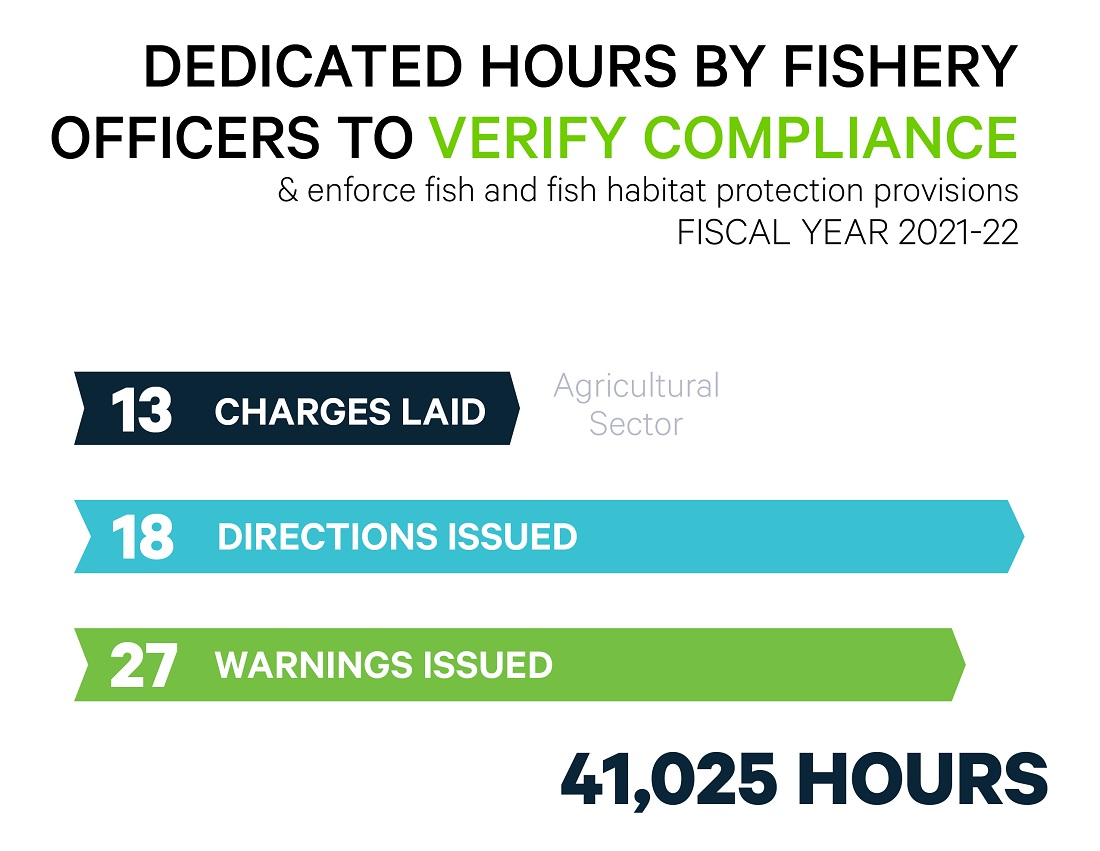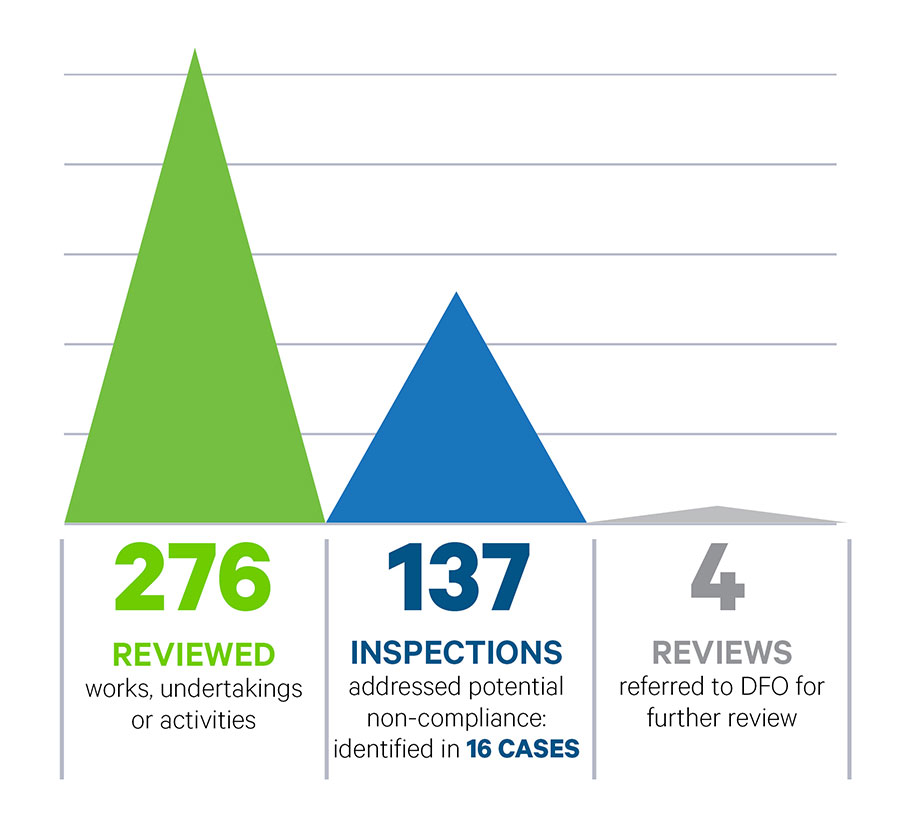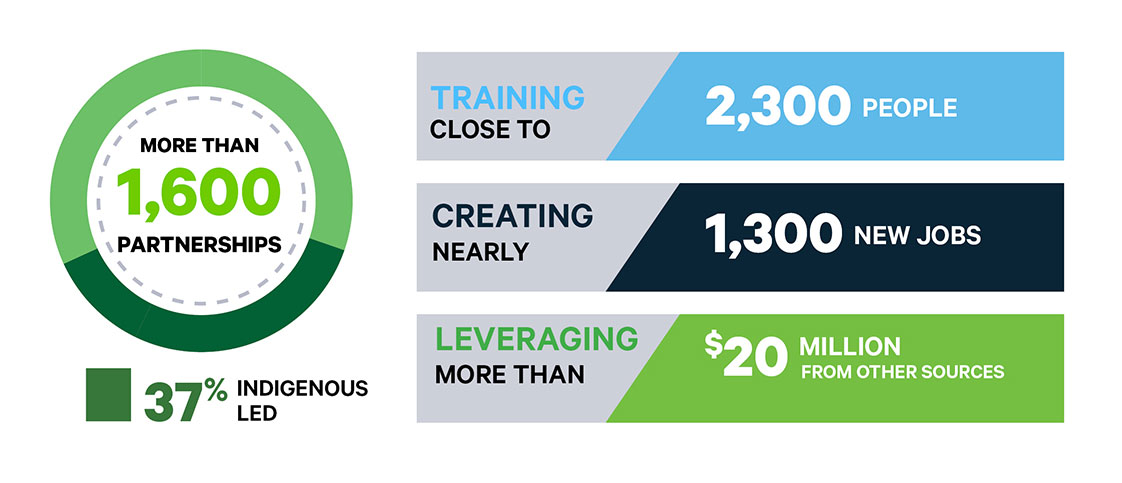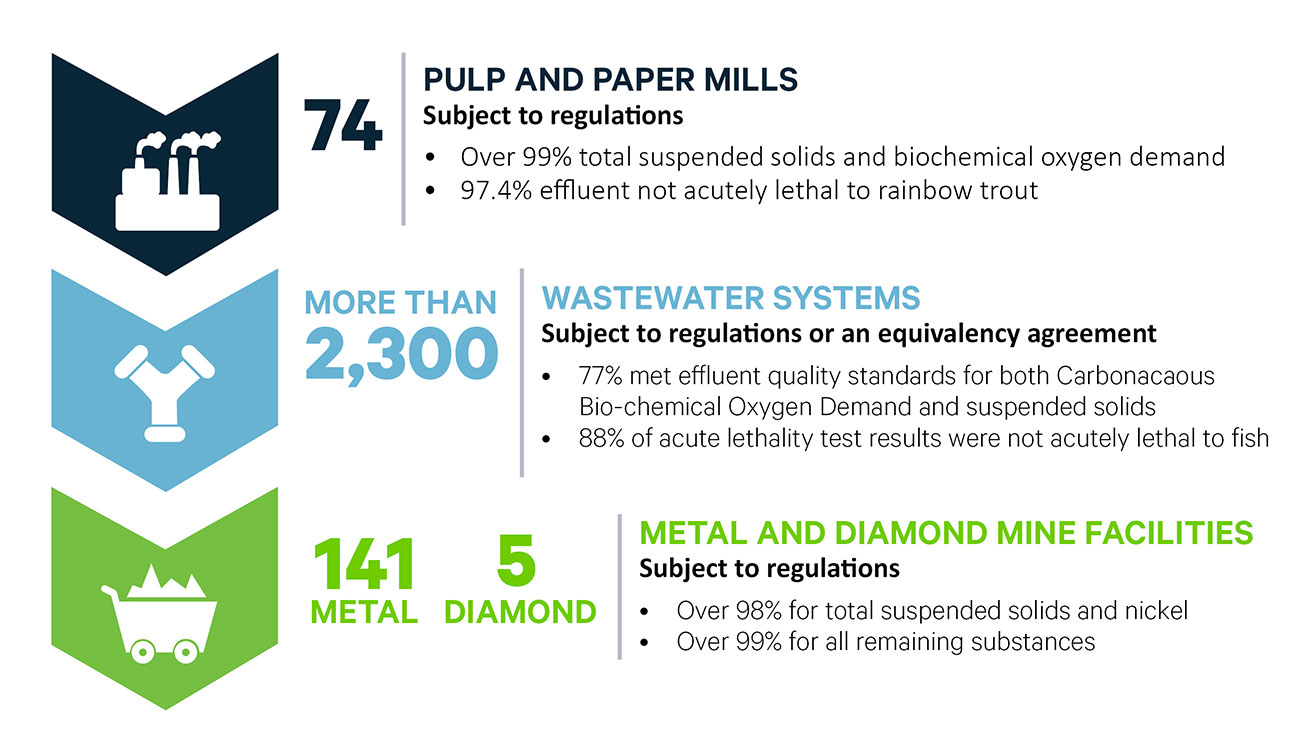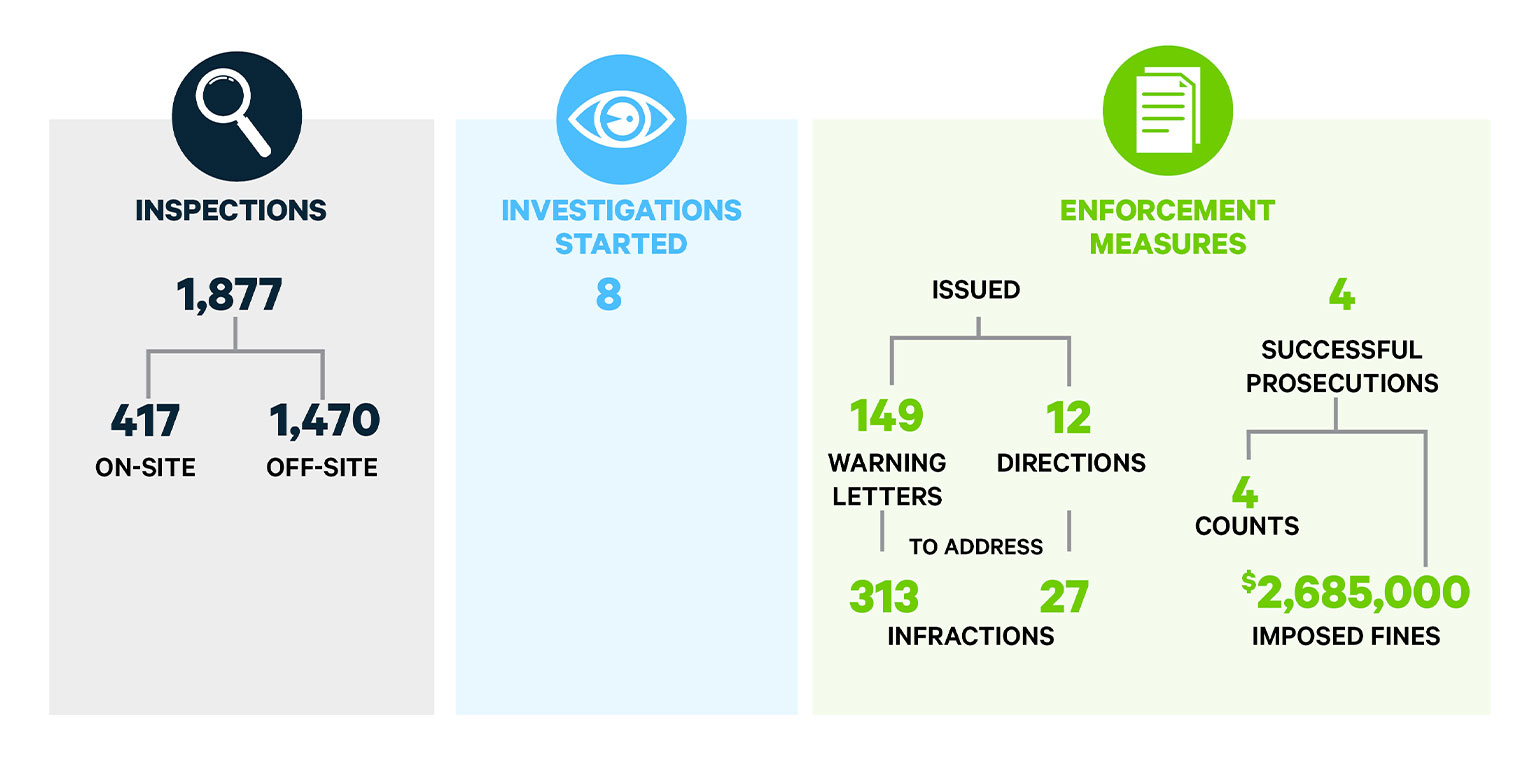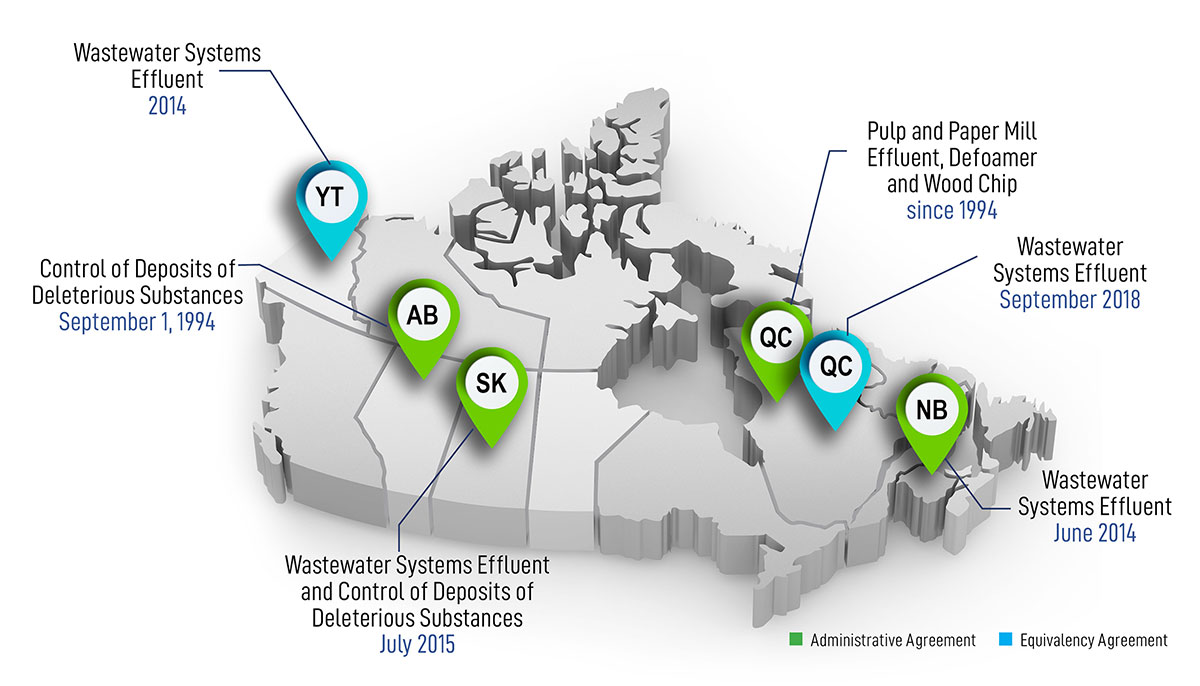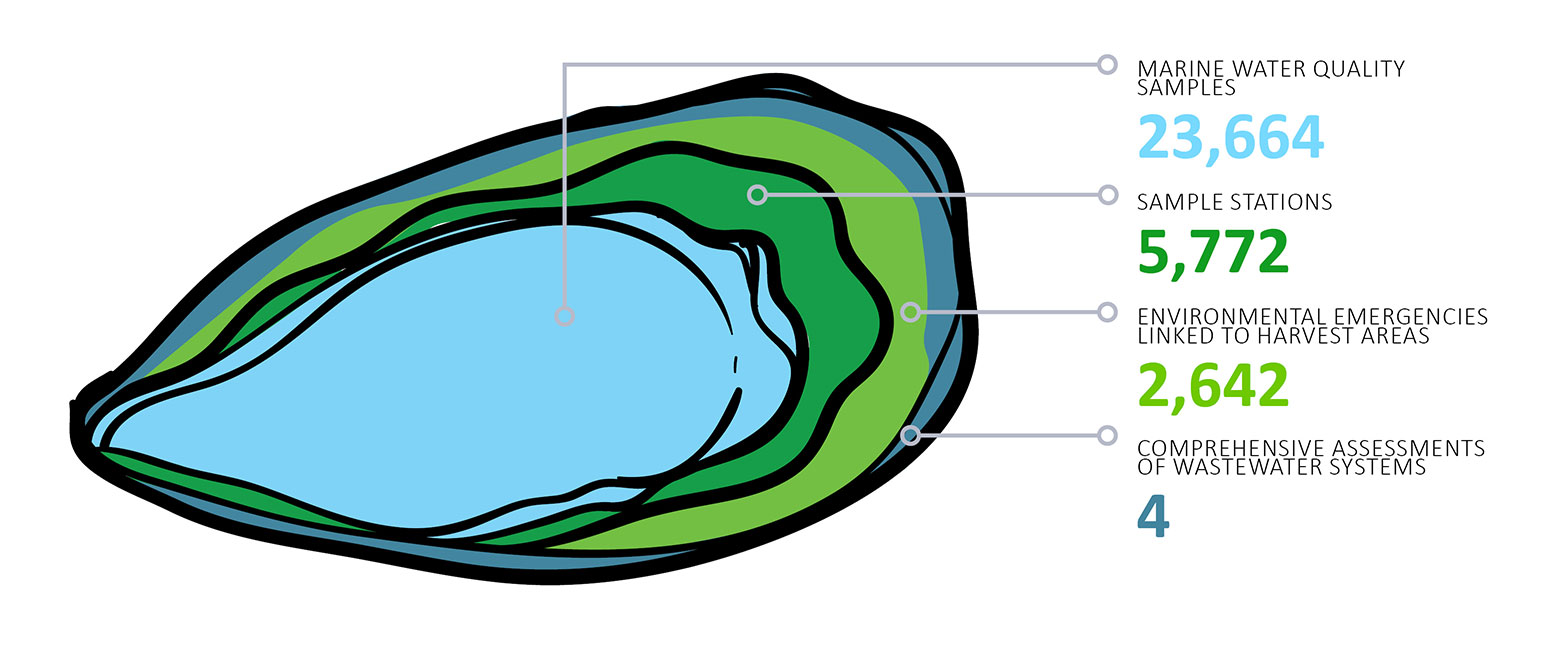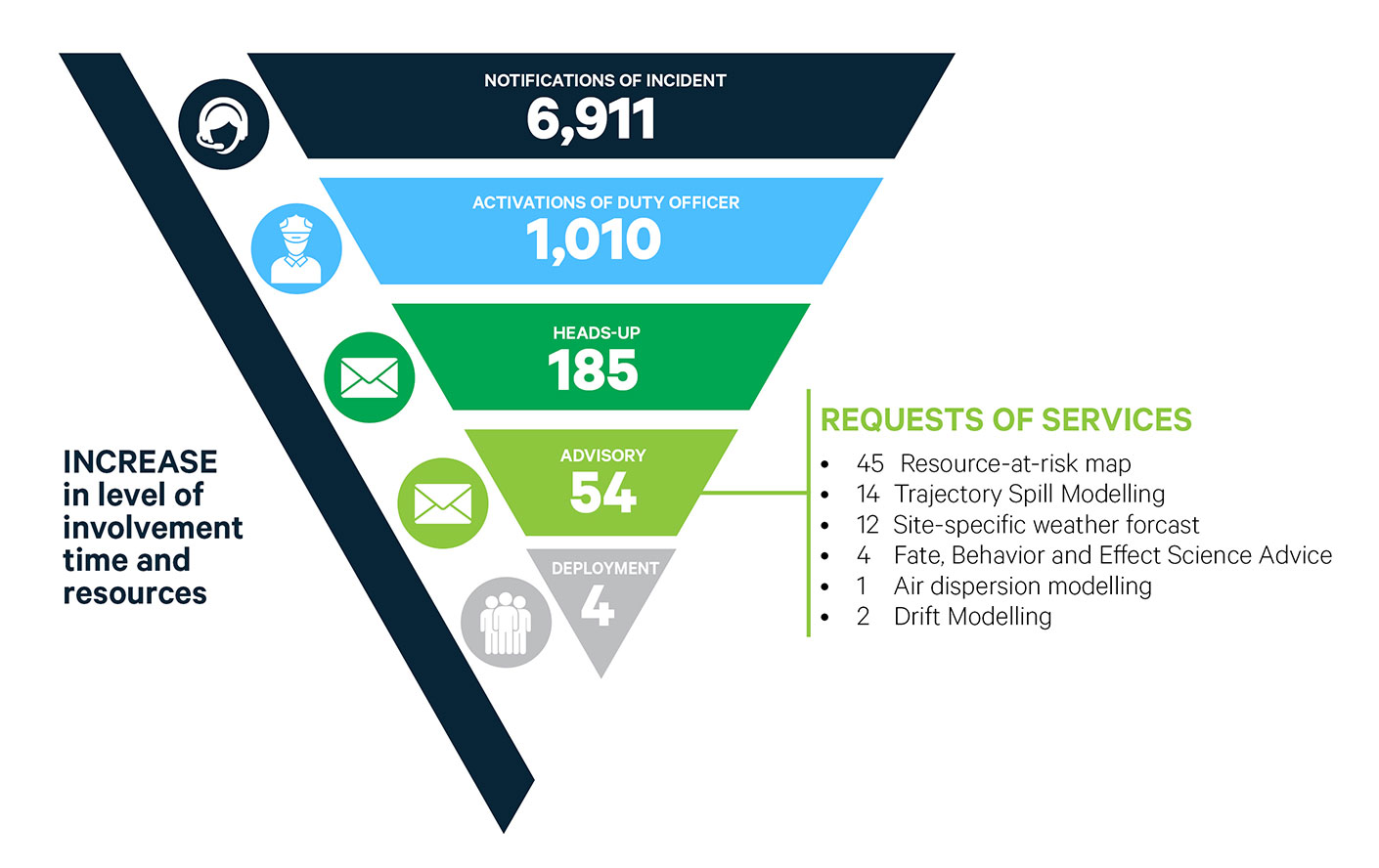Annual report to parliament on the administration and enforcement of the fish and fish habitat protection and pollution prevention provisions of the Fisheries Act - 2021-2022
Fisheries and Oceans Canada and Environment and Climate Change Canada are committed to protecting Canada's environment in ways that benefit future generations while supporting today's growing economy. This means actively working together to achieve an integrated approach to the conservation and protection of fish and fish habitat across Canada and empowering Canadians to be informed and effective in managing threats and impacts to aquatic ecosystems caused by human activities and invasive species. Our efforts include the support and collaboration of Indigenous Peoples, stakeholders, other governments and the international community
This annual report summarizes the administration, enforcement, and other activities undertaken by both Departments between April 1, 2021 and March 31, 2022 to ensure compliance with the fish and fish habitat protection and pollution prevention provisions of the Fisheries Act.
Table of contents
- 1.0 Introduction
- 2.0 Protecting fish and fish habitat
- 2.1 Educating, engaging and advising
- 2.2 Reviewing proposed works and activities
- 2.3 Environmental and impact assessments
- 2.4 Monitoring and enforcing compliance
- 2.5 Monitoring and reviewing energy projects
- 2.6 Protecting aquatic species at risk
- 2.7 Researching and providing scientific advice
- 2.8 Restoring fish and fish habitat
- 3.0 Preventing pollution from entering waters
- 3.1 Educating and promoting compliance
- 3.2 Modernizing and developing pollution prevention regulations
- 3.3 Analyzing self-reported effluent data
- 3.4 Enforcing the pollution prevention provisions
- 3.5 Equivalency and administrative agreements
- 3.6 Monitoring marine water quality for shellfish
- 3.7 Responding to environmental emergencies
- 3.8 Streamlining environmental notifications
- 3.9 Monitoring and enforcing aquaculture activities
- 3.10 Preventing aquatic invasive species
- 4.0 Annex
1.0 Introduction
Each year, the ministers of Fisheries and Oceans (DFO) and Environment and Climate Change (ECCC) report to Parliament on their efforts to administer and enforce the fish and fish habitat protection and the pollution prevention provisions of the Fisheries Act. This has been a legislative requirement since 1990.
This report covers activities from April 1, 2021 through March 31, 2022: a year in which Canadians and the world began to recover from the COVID-19 pandemic, but which still required adaptive planning and creative approaches by our teams to work both “in the field” and from hybrid environments.
The annual report profiles how we carried out our responsibilities, despite any pandemic challenges, including in collaboration with our partners. We also continue to showcase key results and success stories so you can see what we are accomplishing to protect fish and fish habitat and to prevent pollution from entering waters frequented by fish. This includes communicating key statistical information using infographics.
Detailed information about the Fisheries Act, and the way our departments are organized to administer the fish and fish habitat protection and the pollution prevention provisions, are located in the annex at the end of this report. The annex also features tables with complete statistics on our activities to protect fish and fish habitat and to prevent pollution during the 2021–22 reporting year, as well as more year-over-year comparative statistics to enable analysis and increased understanding about the results of our efforts.
1.1 Collaboration
Canada's fish and fish habitat are shared resources that benefit us in social, economic, and ecological ways. Fish and fish habitat are also finite and vulnerable resources, so they must be protected and conserved for future generations. These outcomes are best achieved when governments, partners and stakeholders work together.
DFO and ECCC collaborate each year to put this publication together. We also work together throughout the year to prevent pollution from entering waterways that can harm fish and their habitat and to take broader measures to conserve and protect fish and fish habitat overall. For example, we work together and with other partners such as the Parks Canada Agency to achieve Canada's commitment to conserve 25 per cent of our lands and waters by 2025, and 30 per cent of each by 2030, in order to halt and reverse nature loss in Canada. In addition, DFO collaborates with the Canada Energy Regulator and the Canadian Nuclear Safety Commission to reduce overlaps when they are reviewing the same projects to ensure fish and fish habitat are protected.
Cooperation and partnership with Indigenous Peoples are key features of the Fisheries Act, including provisions that allow the Minister to enter into an agreement with an Indigenous governing body or a co-management body established under land claims agreements to advance the purpose of the legislation.Footnote 1 We also conduct early engagement and consult Indigenous peoples when a decision may affect their rights and, when necessary, accommodate them as a result. We aim to secure free and informed consent prior to issuing Fisheries Act Authorisations.
The Crown–Indigenous working group that was launched in 2020-21 by ECCC to collaboratively explore options to manage the accumulation of oil sands process water in the existing tailings ponds is one such partnership example. Over the reporting year, this working group comprised of nine Indigenous communities and ECCC advanced work using a two-pronged approach. On one hand, the Crown–Indigenous working group initiated an assessment of alternative options, to determine whether regulations authorizing the release of oil sands mining effluent are necessary and justified. On the other hand, because the necessary scientific work can take years to complete, the Crown–Indigenous working group continued the technical and scientific research and analysis needed to set standards to ensure that if regulations are developed, they only allow clean effluent to be released. Any such regulations would only be developed with strict protective standards reflecting the best available scientific information and Indigenous knowledge and would be developed in collaboration with local Indigenous communities.
Provincial and territorial authorities across Canada, as well as resource management boards established under land claims agreements, share a range of natural resource conservation responsibilities, and their laws and actions have the potential to complement or impact the protections afforded by federal legislation and regulations. For example, land-use decisions made by these authorities may have a significant bearing on the quality, quantity, and function of fish habitat in a given watershed.
We collaborate closely with provincial and territorial governments, including the jurisdictions with which we have entered into pollution prevention-related equivalency agreements and/or arrangements, to reduce regulatory duplication and streamline administration related to Fisheries Act provisions. The Canadian Council of Fisheries and Aquaculture Ministers and the Canadian Council of Ministers of the Environment are key venues used to advance these partnerships.
Our collaborations extend to industry and proponentsFootnote 2 involved in or considering a project near water or those involved in sectors that have the potential to affect waterways, as well as to Indigenous Peoples and stakeholders, such as non-governmental organizations and community organizations, that are involved in fish and fish habitat restoration activities. Some of the key results and success stories profiled in this report showcase these collaborations.
2.0 Protecting fish and fish habitat
DFO educates, engages, and advises proponents on how to follow the Fisheries Act and its fish and fish habitat protection provision and associated regulations. We also complete regulatory reviews of development projects to protect fish and fish habitat across Canada, participate in and conduct our own environmental and impact assessments, and monitor and enforce compliance.
Our work is informed by research and scientific advice. We also support projects to restore fish and fish habitat across Canada.
2.1 Educating, engaging and advising
We use a suite of guidance documents to conserve and protect fish and fish habitat. For example, our Fish and Fish Habitat Protection Policy Statement outlines how we interpret and apply the regulatory and non-regulatory tools in the Fisheries Act when we administer the program.
These documents also serve to guide proponents considering or undertaking projects near water. For example, our Offsetting PolicyFootnote 3 describes how a proponent must offset any residual harmful effects on fish and fish habitat using step-by-step procedures to:
- select appropriate measures
- determine the extent of measures needed, and
- ensure monitoring and reporting
Additionally, our Interim Codes of Practice help proponents protect fish and fish habitat when they undertake projects near water that involve:
- beaver dam removal
- culvert maintenance
- end-of-pipe fish protection screens for small water intakes in freshwater
- routine maintenance dredging
- temporary cofferdams and diversion channels, and
- temporary stream crossings
A key part of our Fish and Fish Habitat Protection Program involves educating proponents about our guidance materials which are featured on the Projects Near Water website to ensure that they understand how to comply with the Fisheries Act and Authorizations Concerning Fish and Fish Habitat Protection Regulations.
We also remain available to proponents to provide advice and answer their questions. Over 2021-22, we did this on 5,139 occasions (Table 4).
Throughout the year, we collect, share and report on our education and advising activities using an internal Program Activity Tracking for Habitat system, including data on our review of referrals. We also regularly update the Projects Near Water website with new guidance materials. In February 2021, for example, we added the Interim Policy for Establishing Fish Habitat Banks to Support the Administration of the Fisheries Act and the Species at Risk Act. In addition, summaries of all Fisheries Act authorizations are posted on a public registry for greater public transparency with Canadians.
Engagement is another key component of our program because the future direction of our policies and regulations is shaped, in part, by the insight of our partners and stakeholders, the perspectives of Indigenous Peoples, and the requirement to respect Aboriginal and treaty rights. In 2021-22, we launched Wave 2 of our multi-wave engagement plan to continue the conversation on two topics from Wave 1 and start to discuss five new topics. For this engagement, we encouraged interested parties to submit feedback to us on all seven topics, to attend engagement sessions, and to participate in the online activities taking place on our “Talk Fish Habitat” platform.
The two topics on which we continued Wave 1 engagement were:
- Consideration of Cumulative Effects on Fish and Fish Habitat Position Statement, and
- Prescribed Works and Water Regulations
The topics introduced in Wave 2 were:
- Death of Fish Position Statement
- Existing Facilities and Structures Position Statement
- National Framework for Identifying, Establishing, and Managing Ecologically Significant Areas
- Framework for Aquatic Species at Risk Conservation, and
- Framework to Identify Fish Habitat Restoration Priorities
During 2021-22, we attended virtual workshops and meetings held by Indigenous organizations, partners and interested stakeholders to discuss the engagement topics and raise awareness about the Fisheries Act and its fish habitat protection provisions.
We also provided guidance, training, advice and scientific support about fish and fish habitat implications to persons responsible for managing federal contaminated sites as one of the Federal Contaminated Sites Action Plan's supporting experts. Our support helps these persons minimize impacts to fish and fish habitat, while maximizing the benefits of their site management activities, which include:
- reviewing site classifications and technical documents to ensure that the potential risks and/or impacts to fish and fish habitat have been appropriately considered
- developing guidance material and training on aquatic contaminated sites and,
- promoting regulatory compliance with the Fisheries Act and Species at Risk Act
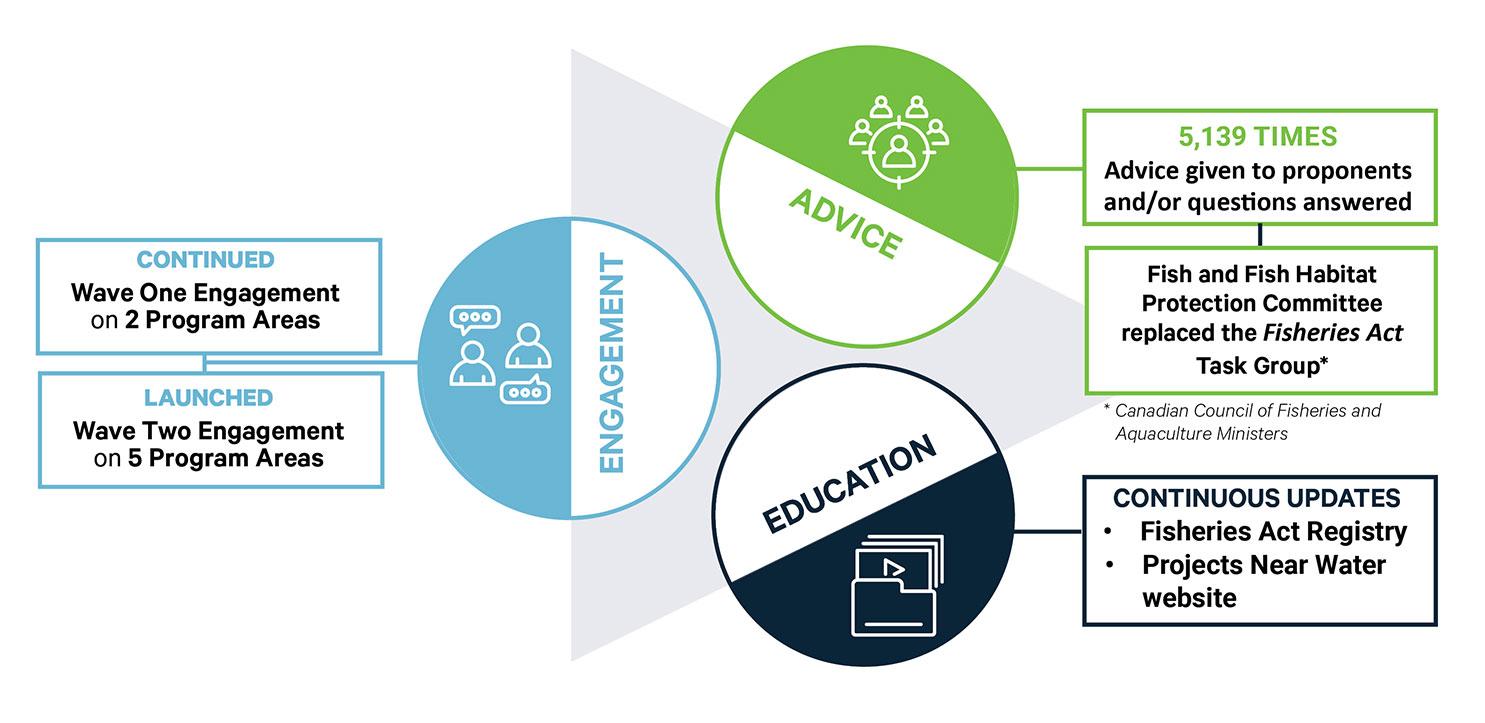
Infographic: Education, engagement and advice – fiscal year 2021-22
Education: Continuous updates on the Fisheries Act Registry and Projects Near Water Website.
Engagement: Continued Wave 1 engagement on 2 Program Areas and launched Wave 2 engagement on 5 Program Areas.
Advice: Advice given to proponents and / or questions answered 5,139 times and the Fish and Fish Habitat Protection Committee replaced the Fisheries Act Task Group (Canadian Council of Fisheries and Aquaculture Ministers)
In the spring of 2021, the Canadian Council of Fisheries and Aquaculture Ministers' Fish and Fish Habitat Protection Committee replaced the 2016–2021 Fisheries Act Task Group, with a renewed mandate to:
- continue the Federal–Provincial–Territorial discussion and information sharing related to fish habitat and provide foundational advice to us on the development of policies and tools required to implement the 2019 Fisheries Act
- consider aquatic Species at Risk Act issues when they intersect with Fisheries Act issues (e.g., regulatory decision-making, stewardship opportunities for fish and fish habitat, cumulative effects, etc.)
The Committee held six virtual meetings over the reporting year to progress its mandate priorities.
Key Result: Continued update of information on authorizations in the Open Data Portal
In 2021-22, we identified the internal departmental processes necessary to publish on the Fisheries Act Registry many authorizations that we have issued for projects. This information is accessible to Canadians through the Common Project Search portal.
2.2 Reviewing proposed works and activities
The Projects Near Water website includes our recommended best practices to help proponents avoid harming fish and fish habitat. These are the Measures to Protect Fish and Fish Habitat. There are also project-specific criteria to help proponents determine if we need to review their projects to ensure that they avoid harming fish and fish habitat. This step in the process helps us focus our site-specific review and advice on the highest-risk projects.
When a proponent's project falls into certain categories, such as those which require specific measures to combat invasive species, or the proponent is unable to meet the criteria to avoid harmful alteration, disruption or destruction of fish habitat and death of fish, they can submit a Request for Review form to us so we can review their project. Any time an aquatic species at risk may be affected by a proponent's proposed works, a review can also be requested. As part of the review process, our officials must verify whether or not the project has the potential to adversely affect aquatic species listed under the Species at Risk Act (SARA) or their critical habitat, so appropriate measures can be taken by the proponent if the project is permitted to proceed.
The Minister may consider issuing an “authorization” pursuant to paragraph 34.4(2)(b) and 35(2)(b) of the Fisheries Act for a project if the harmful alteration, disruption or destruction of fish habitat or death of fish cannot be avoided. Proponents seeking an authorization must submit an application as outlined by the Authorizations Concerning Fish and Fish Habitat Protection Regulations.
Avoid harmful alteration, disruption or destruction of fish habitat or death of fish
Our preference is to conserve and protect fish and fish habitat by avoiding harmful impacts, whenever possible. Proponents are responsible for avoiding harmful impacts resulting from their works, undertakings, or activities.
If an aquatic species at risk or its protected critical habitat could be affected by a proposed project, a Fisheries Act authorization that addresses the requirements under SARA may also be required. This authorization would outline the measures required for the project to be compliant with both Acts. A SARA-compliant authorization is issued under paragraph 35(2)(b) of the Fisheries Act to act as an authorization under both statutes.
The Applicant's Guide Supporting the “Authorizations Concerning Fish and Fish Habitat Protection Regulations” is available to guide proponents through the process of applying for an authorization.
Between April 1, 2021 and March 31, 2022, we reviewed 5,287 development proposals (referrals) and issued 212 authorizations.Footnote 4 We also achieved a 96 per cent compliance rate with our service delivery standards to confirm that applications for authorizations were complete and adequate within the regulated 60-day time limit and a 99 per cent compliance rate for processing these applications within the 90-day time limit.
In addition to project-specific authorizations, we managed 195 agricultural municipal drain class authorizations for maintenance activities in southern Ontario in 2021-22, as shown in Table 5. These types of authorizations use a standard approach to eliminate the need for site-specific reviews, but they are still tracked and reported because they authorize works, undertakings or activities that may result in the death of fish (by means other than by fishing) and the harmful alteration, disruption, or destruction of fish habitat.
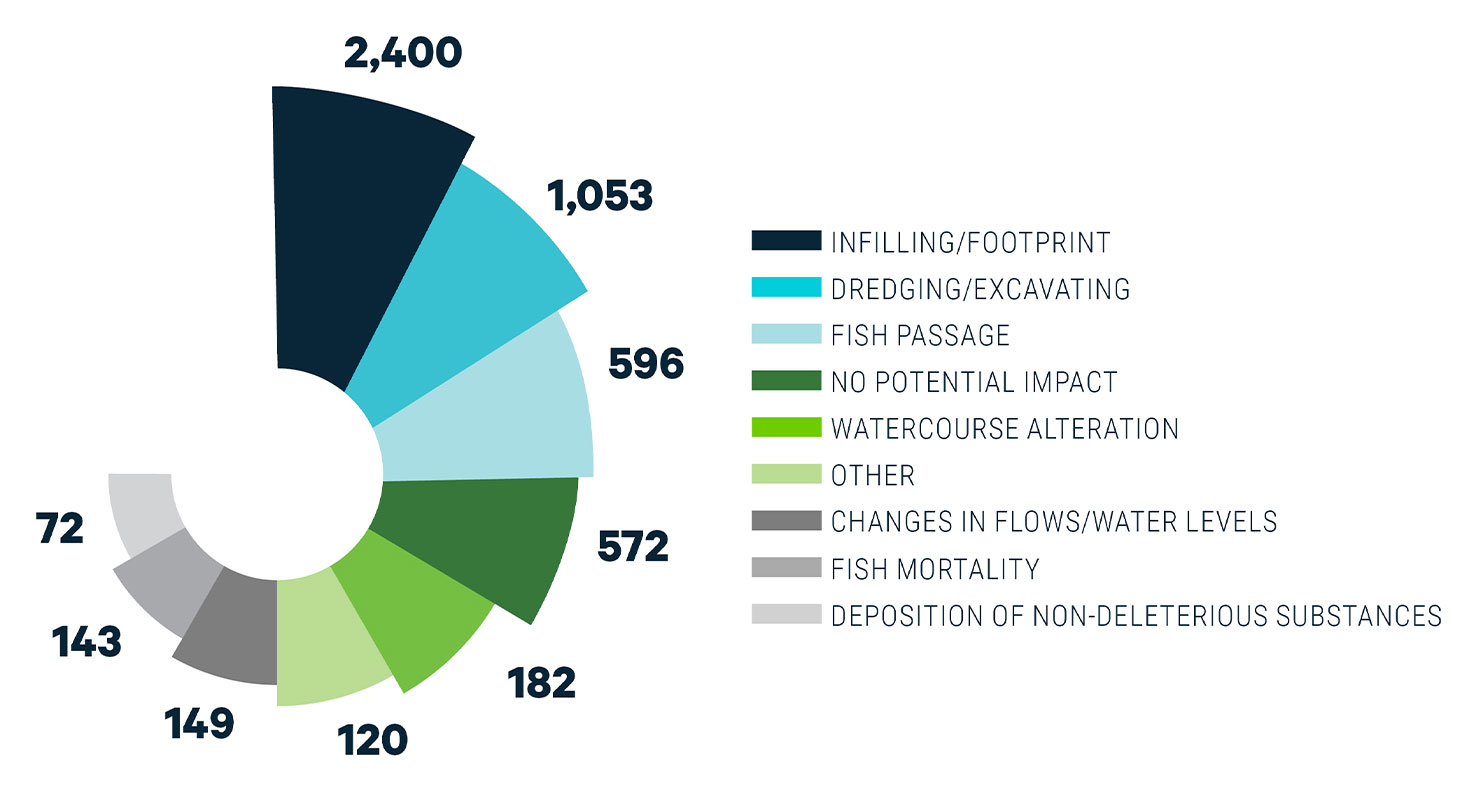
Infographic: Summary of habitat referrals by primary impact – fiscal year 2021-22
Derived from total referrals presented in Table 3 on Page 42
- Infilling/Footprint: 2,400
- Dredging/Excavating: 1,053
- Fish Passage: 596
- No Potential Impact: 572
- Changes in Flows/Water Levels: 149
- Watercourse Alteration: 182
- Fish Mortality: 143
- Deposition of Non-Deleterious Substances: 72
- Other: 120
2.3 Environmental and impact assessments
Some projects that require authorizations under the Fisheries Act or permits under the Species at Risk Act may first require a federal environmental or impact assessment. This may be undertaken under the authority of the Impact Assessment Act or another federal legislation depending on the geographic area. There may also be situations where a project is undergoing an assessment under the Canadian Environmental Assessment Act, 2012 (the predecessor to the Impact Assessment Act).
When an environmental or impact assessment is being carried out, advice from DFO is collected from multiple programs and sectors to help the assessment-leading party validate potential project impacts and required mitigation as it relates to our mandated responsibilities. The type of advice we give is based on our analysis of the project's impacts, and it may include, but is not limited to, fish and fish habitat aquatic species at risk and their habitat, effects on the rights of Indigenous Peoples, or matters related to the Canadian Coast Guard. Departmental advice is provided to the entity leading the assessment for consideration and to inform their environmental or impact assessment decision. Our Minister may also have additional responsibilities under federal environmental assessment legislation; namely, in northern Canada, as a decision-making authority (e.g., responsible minister) if the project requires a Fisheries Act authorization and/or Species at Risk Act permit.
When we consider issuing a Fisheries Act authorization and/or Species at Risk Act permit for a project to proceed on federal lands, we may first need to undertake an assessment to identify any potential significant environmental effects of the project. We may also provide advice on potential impacts to fish and fish habitat and mitigation measures to the federal partners that are required to undertake an assessment under section 82 of the Impact Assessment Act.
When projects require both an environmental or impact assessment and a regulatory approval, we coordinate with federal partners to consult Indigenous peoples as required by the Duty to Consult. These consultations are carried out during the environmental or impact assessment as well as the regulatory phase. We are prohibited from issuing an authorization under the Fisheries Act or a permit under the Species at Risk Act until the environmental or impact assessment has concluded, and it has been determined that the project may proceed to the regulatory phase.
2.4 Monitoring and enforcing compliance
Monitoring to promote compliance with the fish and fish habitat protection provisions helps Canada conserve and protect fish and fish habitat, including aquatic species at risk. Promoting compliance through enforcement activities is also key to achieving these outcomes.
Fishery officers and fishery guardians are individuals designated by the Minister of Fisheries and Oceans under the Fisheries Act (section 5). Fishery officers are designated to monitor and enforce provisions of the Fisheries Act, including the fish and fish habitat protection and pollution prevention provisions. The enforcement powersFootnote 5 of a fishery guardian are limited to the powers needed to carry out their duties, such as inspection and seizure of certain items. This means fishery guardians largely ‘observe, record, and report' violations of the Fisheries Act.
Our fishery officers devote active time and effort to monitor and enforce compliance by:
- conducting habitat patrols, inspections and investigations
- working with habitat biologists, some of whom are designated as fishery guardians, on sites with authorized works, undertakings or activities
- responding to reports of potential habitat violations from members of the public
- assisting in habitat protection education activities held with the public
- working with other enforcement partners to support habitat protection
- working with Crown counsel on prosecutions, and
- other activities, as needed
When habitat violations are identified, fishery officers may issue warnings or directions to address the non-compliance. If warranted, they may also undertake investigations, lay charges and when necessary, undertake major cases and special investigations. These enforcement actions are a part of a broader compliance promotion effort that combines monitoring, control and surveillance with education, shared stewardship, and stakeholder engagement.
During fiscal year 2021-22, fishery officers:
- spent 41,025 hours verifying compliance with and enforcing the fish and fish habitat provisions
- issued 27 warnings
- issued 18 directions, and
- laid 13 charges
Our habitat protection compliance efforts largely focused on rural and urban development, and agriculture- and transportation-related activities. More than half of the charges laid during 2021-22 related to non-compliance in the agriculture sector.
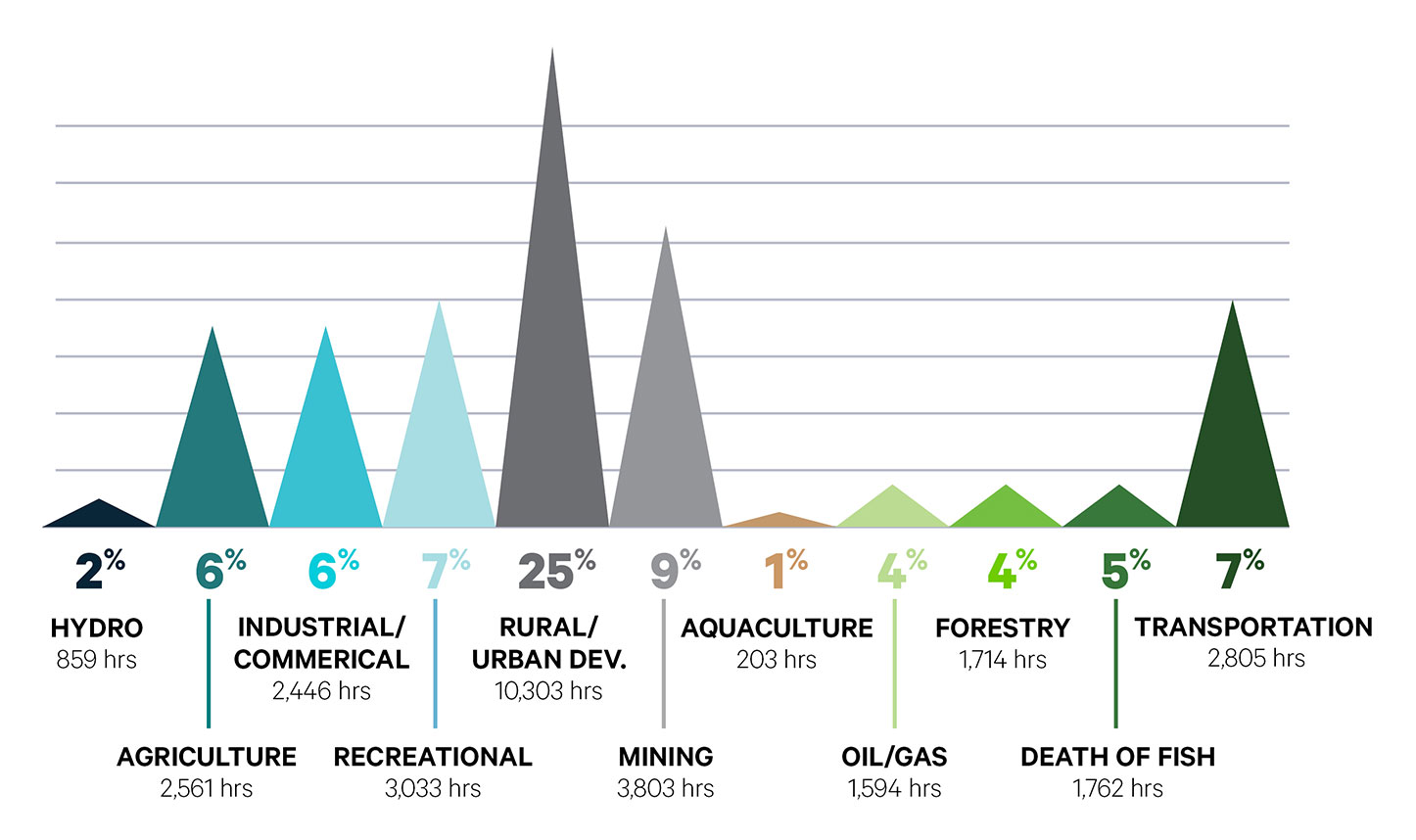
Infographic: Allocation of compliance effort by habitat sector – fiscal year 2021-22
Habitat Activities Hours Percentage:
- Agriculture 2,561 6%
- Aquaculture 203 1%
- Death of Fish 1,762 5%
- Forestry 1,714 4%
- Hydro 859 2%
- Industrial/Commercial 2,446 6%
- Mining 3,803 9%
- Oil/Gas 1,594 4%
- Recreational 3,033 7%
- Rural/Urban Dev. 10,303 25%
- Transportation 2,805 7%
As shown in Table 6 in Annex 4.4, compliance efforts were also conducted for non-industry reasons (2,958 hours or 7%, natural events (289 hours or 1%), and as general patrols (6,695 hours or 16%).
Key Result: More monitoring and compliance promotion of fish and fish habitat
Fishery officers have been devoting more of their efforts to address fish habitat issues since the Fisheries Act was amended in 2019. New work elements were also created in the Conservation and Protection's occurrence and time reporting system to help officers better track their efforts to protect fish and fish habitat. This includes responding to natural events, conducting habitat-specific work in the office and leveraging general patrols for habitat-related compliance promotion work. As a result, the total hours spent by fishery officers on habitat-related work has continued to increase each fiscal year.
Success story: Successful conviction under the Fisheries Act – Chilcotin River, British Columbia
Fishery officers in Williams Lake, British Columbia conducted a lengthy investigation of harm to fish and fish habitat along the Chilcotin River, near Redstone. This work uncovered offences that had occurred between 2016 and 2018 on three privately owned ranch and crop lands.
The defendant has since been found guilty on three counts of violating section 35(1) of the Fisheries Act and sentenced to pay a global fine of $280,000. This fine is held in trust by the Environmental Damages Fund to conserve and protect salmon or salmon habitat or to restore salmon habitat in the Chilcotin region. The court also ordered the defendant to remediate the impacted sites within two years and submit four reports which comprehensively document the work done and the health of the riparian system for the next decade.
Success story: Aerial Surveillance Project across Ontario, Manitoba, Saskatchewan and Alberta
In July 2021, fishery officers used a Dash-8 surveillance aircraft to conduct aerial-based inspections of habitat and species at risk sites across four provinces: Ontario, Manitoba, Saskatchewan and Alberta. The mission was part of a pilot surveillance project set up to identify quality targets to monitor for compliance with the Fisheries Act and Species at Risk Act and to collect evidence in support of active investigations. It was the first aerial surveillance mission of its kind in these four provinces.
The aerial surveillance mission took place over four consecutive days. Fishery officers directed the flight crew and equipment operators to identify targets and capture valuable observations from photo and video data at each of the 44 sites. The overall success of this pilot project is expected to lead to future opportunities to use the Dash-8 platform.
Success story: Helicopter patrol in Quebec
In 2021-22, we used a patrol helicopter in Quebec to increase our ability to cover a larger territory and conduct more effective monitoring. As a result, we flew 3,600 kilometers to target at-risk waterways across the province. This type of patrol captures clear images of the shoreline and its condition in a very short period of time, which can then be used to demonstrate the extent of any harmful alteration, disruption or destruction of fish habitat, including pre-existing conditions of each site. The images are particularly useful in areas where there is a high likeliness of riparian construction and private development. Given that this type of data collection is not currently conducted by any other means, the patrol helicopter will continue to be used throughout the province to significantly increase the presence of fishery officers in areas most at-risk to harmful activities.
2.5 Monitoring and reviewing energy projects
DFO has memoranda of understanding (MOU) with the Canadian Nuclear Safety Commission (CNSC) and the Canada Energy Regulator (CER) to outline areas of cooperation when these federal entities are reviewing the same projects, while still ensuring that fish and fish habitat are protected under the Fisheries Act. Both of these entities have fisheries experts to review applications for projects under their respective legislation, and are also well positioned to consider potential effects to fish, fish habitat and aquatic species at risk.
CNSC regulates the use of nuclear energy and materials, including nuclear facilities under the Nuclear Safety and Control Act. Fisheries experts at the CNSC review licensee documentation to ensure appropriate measures are being applied to avoid and mitigate impacts to fish and fish habitat, including aquatic species listed under the Species at Risk Act and their critical habitat.
The potential of energy infrastructure projects to impact fish and fish habitat are reviewed by the CER under the authority of the Canadian Energy Regulator Act. Typically, this means reviewing proposals for the installation or maintenance of pipeline watercourse crossings.
When impacts to fish and fish habitat cannot be avoided during these nuclear energy or energy infrastructure review activities, DFO officials become involved. The Minister of Fisheries and Oceans also remains responsible for decisions on the issuance of Fisheries Act authorizations and conditions of authorization, as well as for permits under the Species at Risk Act.
In 2021-22, we continued to collaborate with CNSC to ensure the protection of fish and fish habitat near nuclear facilities. During this reporting period, no Fisheries Act authorizations were issued to nuclear generating stations in Canada. The CNSC also continued to review the fish and fish habitat protection monitoring reports required of nuclear generating stations that were issued Fisheries Act authorizations in the past. During the reporting period, there were no reports of non-compliance with the fish and fish habitat protection provisions of the Fisheries Act or of any potential impacts to aquatic species at risk or their critical habitat.
Over the same time frame, the CER reviewed 276 proposed works, undertakings or activities in or near water to determine whether appropriate mitigation measures were being applied and whether impacts to fish and fish habitat were likely to occur. This included 180 works, undertakings or activities associated with new applications and 96 Operations and Maintenance works, undertakings or activities associated with existing projects. During this review, the CER inspected 137 projects that involved fish and fish habitat and, as a result, found and addressed 16 instances of potential non-compliance with the Canadian Energy Regulator Act or the Canada Energy Regulator Onshore Pipeline Regulations. They also referred four projects to DFO for further review.
In 2021-22, we began working with counterparts at both the CER and CNSC to revise our MOUs to reflect legislative changes, such as the modernized Fisheries Act, and the changed name of the National Energy Board to the Canada Energy Regulator. While work is ongoing, on October 25 2021, the CER and DFO signed an addendum to their MOU, which stipulates that we will now receive referrals directly from proponents for all activities proposed to occur in the critical habitat of listed aquatic species at risk.
2.6 Protecting aquatic species at risk
The fish and fish habitat protection provisions of the Fisheries Act enable us to take a holistic approach to conserve and protect fish and fish habitat. We also apply the relevant provisions of other Acts and regulations when making decisions to ensure that fish and fish habitat are protected. This includes the Species at Risk Act (SARA).
For example, if a proponent's proposed work, undertaking or activity is likely to result in an impact prohibited under SARA, our regulatory review would consider whether or not the permitting conditions under SARA could be met. If it is possible, the Fisheries Act authorization we would issue to allow the work would also act as a Species at Risk Act permit. This includes imposing certain pre-conditions and requirements on the proponent in carrying on the work, undertaking or activity. If the conditions could not be met, we would refuse the authorization.
Among other things, SARA protects the most at-risk species and their critical habitat by prohibiting:
- the killing or harming species listed as threatened, endangered and extirpated
- any damage or destruction of a species' residence, and
- destruction of critical habitat for species at risk (once this critical habitat has been identified)
Every year, we report to Parliament on our activities to administer the provisions of the Species at Risk Act that apply to aquatic species at risk, in a publication that is produced by ECCC. This includes highlighting key results and success stories.
2.7 Researching and providing scientific advice
Aquatic ecosystems include interdependent plants, animals, and microorganisms. DFO scientists help fisheries managers and others understand the impacts of multiple human activities undertaken in and around the same aquatic ecosystem by researching and providing scientific advice. This advice covers a broad array of topics, including habitat science, species at risk, marine mammals, and cumulative effects.
Promote sound decision-making
Our decisions are informed by the best available science, technical information, and Indigenous knowledge. They are also guided by the application of the precautionary approach and a risk-based approach.
Our peer review process for providing scientific advice is coordinated by the Canadian Science Advisory Secretariat. The scope of this advice ranges from informing policy development to advising on a specific project. Examples of the research products and scientific advice given in 2021-22 included:
- Science advice to the Fish and Fish Habitat Protection Program on estimating impacts and offsets for death of fish
- Cumulative effects considerations for integrated planning in DFO
- Information needs for considering cumulative effects in fish and fish habitat decision-making
- Assessment of the ecological Impact of Water-Level Drawdown on Lake Chubsucker (Erimyzon sucetta) in the St. Clair National Wildlife Area
- Hydrometeorological conditions for Atlantic salmon rivers in the Maritime provinces
The results of our scientific research are published and made publicly available. They are also shared with officials responsible for the conservation and protection of fish and fish habitat:
- as peer-reviewed scientific advice or in fact sheets, and
- during scientific workshops and briefings, and/or personal consultations
During the pandemic, in 2021-22, the Department continued to leverage strong connections and co-management collaborations with partners and stakeholders to carry out research and monitoring work in the field. Our collaborations with communities in the North and the Arctic were especially important as they ensured the safe continuation of many important science projects in these regions.
Key Result: Estimating impacts and offsets for the death of fish
In April 2021, we held a national peer review process to produce science advice on the methods to quantify the impacts on fish and the offsets for the death of fish resulting from a work, undertaking or activity other than fishing. A research document entitled ‘Estimating impacts and offsets for the death of fish' (Koops et al. 2022) that resulted from this process reviews the methods that can be used to quantify the losses from the death of fish by means other than fishing, factors to consider when assessing the impacts on fish populations and communities, and measures to offset the death of fish. The document formed the basis of the science advisory process and will help us better assess impacts and offsets in the future within the legislative context of the Fisheries Act and/or the Species at Risk Act.
2.8 Restoring fish and fish habitat
The goal of fish habitat restoration is to rebuild healthy and functioning ecosystems that support fish throughout their lifecycles. This includes healthy water levels and temperatures, aquatic plants, appropriate shade along the shore, and many other ecosystem features. Fish habitat restoration projects occur along our coastlines, in estuaries, along riparian zones, and through to our inland waterways.
We have a number of habitat restoration programs underway that are funded through the $1.5 billion Oceans Protection Plan. Its $75 million Coastal Restoration Fund, for example, is supporting more than 60 collaborative projects to:
- develop and implement coastal restoration plans and projects
- address threats and stressors to marine species, and
- build the capacity of Indigenous groups and communities to undertake and monitor projects
The Coastal Restoration Fund is also contributing to the objectives set for the United Nations Decade on Ecological Restoration; namely, targets related to ecosystem restoration contained in the 2030 Agenda for Sustainable Development, the Aichi Biodiversity Targets 10, and the post-2020 global biodiversity framework.
In 2021-22, we learned valuable lessons to apply going forward regarding prioritizing advanced planning for Coastal Restoration Fund projects. This involved clearly identifying national and regional coastal restoration priorities during the design and early implementation phase of the program, which ensured that funded projects aligned with identified priorities. Funding studies and planning also enhanced the effectiveness and efficiency of projects by allowing recipients to prioritize needs and determine appropriate measures to restore sites, which will help ensure their long-term sustainability. In addition, we learned that the requirement for project monitoring will increase the understanding of the long-term benefits of the funded project results and allow recipients to maintain project benefits on a longer-term basis.
Since it began, the Coastal Restoration Fund has facilitated more than 1,600 partnerships (including close to 700 Indigenous partnerships), provided training for 2,300 people, and created close to 1,300 new jobs. The program has also leveraged more than $20 million from other sources. From the outset, the program prioritized projects being led by, and involving, Indigenous groups and communities. As a result, almost 100 per cent of projects involve Indigenous partners and 37 per cent of projects are Indigenous-led.
Success Story: Restoring a healthy Placentia Bay coastal ecosystem ($4,779,255 investment between 2017 and 2022)
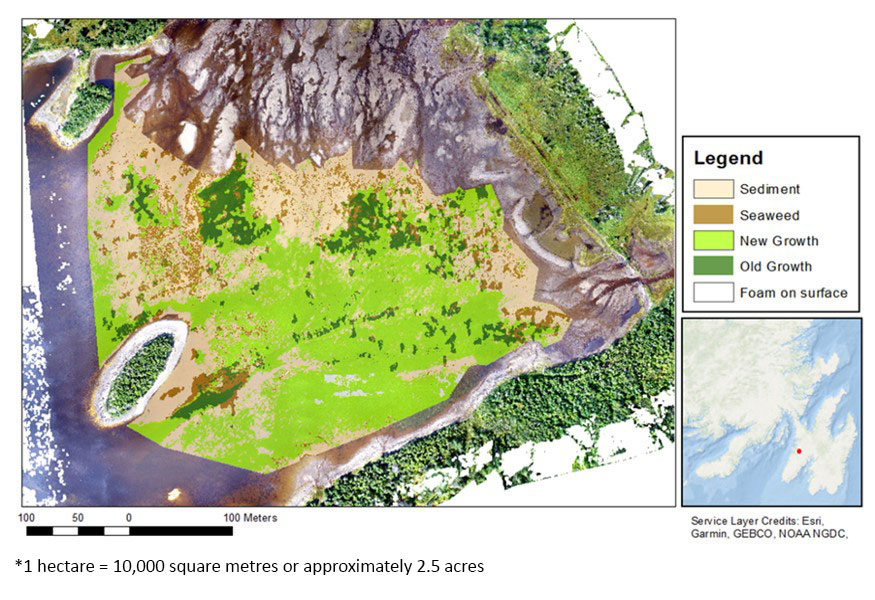
Infographic: Drone image of Northeast Arm, Placentia Bay, showing new eelgrass meadow growth as of Fall 2021
The Fisheries and Marine Institute at the Memorial University of Newfoundland successfully restored four eelgrass sites in the province using learned methods of seed dispersal and sod transplantation. Specifically, the project effectively mitigated stressors to the eelgrass beds and restoration sites by removing 375 metric tonnes of the invasive European green crab. They also worked to enhance the coastal habitat in the project sites by installing 57 artificial reefs in the deeper waters surrounding the sites.
The eelgrass restored by this project should sequestrate around four tonnes of carbon per year in the coming years. The revegetated eelgrass should also provide renewed habitat for coastal fish and shellfish species in Placentia Bay. The Marine Institute has already observed colonization by several new species in the restored beds, including the American eel.
3.0 Preventing pollution from entering waters
ECCC educates and promotes compliance to help the industries and communities we regulate follow the Fisheries Act and its pollution prevention provisions. We also work with these partners to develop, improve, and streamline pollution prevention-related regulations.
Throughout the year, our environment enforcement officers conduct both planned and unplanned inspections to verify compliance and respond to incidents. They also carry out investigations to gather evidence required to prosecute offenses.
At the same time, staff at ECCC analyze self-reported effluent data from regulated industries, monitor the waters used as shellfish growing areas for pollution, and respond to emergencies to prevent pollution from entering waters that are frequented by fish across Canada.
The pollution prevention provisions of the Fisheries Act that relate to aquaculture activities and which serve to prevent, control, and eliminate aquatic invasive species are administered and enforced by DFO.
3.1 Educating and promoting compliance
We increase awareness and understanding about the importance of preventing pollution from entering waters frequented by fish and the consequences of non-compliance among the industries and communities that we regulate. These include the:
- pulp and paper sector
- metal and diamond mining sector
- wastewater systems run by most federal, provincial and municipal governments, private companies, and Indigenous communitiesFootnote 6
We share this information via email and website postings, in letters, as brochures or other documents, and during site visits and information sessions. For example, in 2021‒22, we worked directly with Indigenous communities and Tribal Councils, First Nations technical associations, Indigenous Services Canada, and Circuit Riders to build awareness and understanding of the regulatory requirements of the Wastewater Systems Effluent Regulations. We also continued to help these communities and their supporting agencies by participating in Indigenous-focused conferences and workshops, creating user-friendly compliance material for owners/operators, providing regular reporting reminders, and offering meetings to discuss any reporting challenges. We continued to engage First Nations communities and their supporting agencies to determine if communities are subject to the Wastewater Systems Effluent Regulations, and to increase their capacity to conduct ongoing sampling and reporting to comply with the regulations.
Key Result: Improving online guidance materials for the metal and diamond mining sector
In 2021–22, we renewed the Metal and Diamond Mining Effluent webpage to make it easier to navigate and more visually appealing. At the same time, we updated the online guidance material on the Metal and Diamond Mining Effluent Regulations to ensure that it was accurate and useful for the regulated community and interested Canadians. The webpage features quick links to mining fact sheets and a Single-Window Information Manager.
In addition, we promoted new regulatory requirements under the Metal and Diamond Mining Effluent Regulations to the mining industry by publishing a bilingual, plain-language article about the requirements in the Fall 2021 Issue of Canadian Mining Magazine. The article was then shared with regional mining associations so they could promote the information directly with their members. This collaboration helped us maximize the impact of our messaging.
3.2 Modernizing and developing pollution prevention regulations
Eight regulations have been developed to date to protect waters that are frequented by fish from pollution. The regulations achieve this outcome by controlling the type and amount of substances that can be deposited into waterways by certain industries and wastewater systems or by setting other requirements that would support the protection of fish, fish habitat and human use of fisheries resources.
To ensure regulations remain effective as industries and governments change over time, we regularly initiate regulatory updates to strengthen environmental protections, improve administrative efficiencies, and reduce any unnecessary regulatory burden on industry. During 2021-22, for example, we continued to analyze the input of stakeholders gathered during consultations related to the modernization of the Pulp and Paper Effluent Regulations and to develop an updated consultation document for further engagement.
Over 2021-22, we also advanced the development of Coal Mining Effluent Regulations. For example, we published an updated proposed approach to develop these regulations in January 2022 based on the feedback we received on previous proposals. We also welcomed written comments on the proposed approach from industry, provinces, territories, Indigenous groups, and other interested parties in February 2022. At the same time, we held discussions with these partners and stakeholders so they could understand the proposed approach and comment on it directly. We are now using this input to further refine the proposed approach and enhance engagement with Indigenous communities.
In 2021-22, the Crown–Indigenous Working Group that was set up to consider the development of oil sands mining effluent regulations continued to examine oil sands process-affected water in existing tailing ponds. This working group, which includes members from nine Indigenous communities, also started exploring alternatives to the release of treated effluent to ensure that all options are considered before a decision is made to regulate.
Meanwhile, ECCC continued to analyze how a separate regulatory framework could be developed for wastewater systems in the North and the Arctic, which are not subject to the current Wastewater Systems Effluent Regulations. This includes wastewater systems in the Northwest Territories, Nunavut, and north of the 54th parallel in Quebec and Newfoundland and Labrador.
Key Result: Publishing an updated proposed approach to develop Coal Mining Effluent Regulations
Over 2021-22, we also worked to advance the development of Coal Mining Effluent Regulations under the Fisheries Act. For example, we published an updated proposed approach in January 2022, based on the feedback we received on previous proposals. In February 2022, we held discussion sessions with Indigenous communities, Environmental Non Governmental Organizations, industry, and provinces to communicate the proposed approach and receive comments. We welcomed written comments on this proposed approach from these partners and stakeholders until March 2022. We are now using this input to further refine the proposed approach and enhance engagement with Indigenous communities.
3.3 Analyzing self-reported effluent data
Every year, we analyze the effluent data reported by facilities subject to Fisheries Act regulations; namely, pulp and paper mills, metal and diamond mines, and community wastewater system facilities. The most recent year for which data has been pooled, tabulated, and analyzed at an aggregate level is 2020.
Our analysis of the 2020 monitoring data that was self-reported by the 74 pulp and paper mills subject to regulations shows that facilities continue to report high rates of compliance with effluent quality limits:
- over 99 per cent for total suspended solids and biochemical oxygen demand, and
- 97.4 per cent for the requirement that effluent not be lethal to rainbow trout
The compliance rate with environmental effects monitoring requirements was 96 per cent in 2020 and 86 per cent in 2021. The reduction in compliance level for pulp and paper mills' environmental effects monitoring requirements is due to some mills reporting their sublethal toxicity tests results not during the calendar year they were required to, but the following year.
Our analysis of the 2020 data self-reported by 141 metal and five diamond mine facilities subject to regulations shows that companies continue to report high rates of complianceFootnote 7 with the monthly mean concentration limits:
- above 98 per cent for suspended solids and nickel, and
- above 99 per cent for all remaining substances
The 2020 compliance rate for the requirement that effluent not be lethal to fish was 99 per cent. The compliance rate for environmental effects monitoring requirements was 93 per cent in 2020 and 92 per cent in 2021.
We analyze self-reported data on effluent quality results and the volumes deposited by more than 2,300 wastewater systems that are subject to regulations or are under an equivalency agreement. Medium and large wastewater systems are also required to conduct lethality tests. In 2021, our analysis of the reports from regulatees shows that:
- 77 per cent met the effluent quality standards of 25 mg/L for both Carbonaceous Biochemical Oxygen Demand and suspended solids, and
- 88 per cent of the lethality test results were not lethal to fish
3.3.1 Transitional authorizations
Under the Wastewater Systems Effluent Regulations, owners or operators of a wastewater system that is subject to regulations and not designed to achieve the national effluent quality standards were able to apply for a Transitional Authorization before June 30, 2014. These authorizations established the conditions under which the wastewater systems could continue to operate, while setting a deadline to upgrade the system (end of 2020, 2030 or 2040) so it would meet the mandatory national effluent quality standards.
We issued transitional authorizations for 65 wastewater systems, including five systems located in Quebec which are now subject to an equivalency agreement and managed by the Province of Quebec. Of the 60 transitional authorizations that we still manage, 15 systems have completed upgrades. Of the remaining 45:
- 7 transitional authorizations expired on December 31, 2020Footnote 8
- 9 must meet effluent quality standards by December 31, 2030, and
- 29 must meet effluent quality standards by December 31, 204029 must meet effluent quality standards by December 31, 2040
Key Result: Upgrades to the Greater Nanaimo Pollution Control Centre reduce pollutants entering the Georgia Strait
In 2021, the Regional District of Nanaimo completed upgrades to its secondary treatment system at the Greater Nanaimo Pollution Control Centre. This facility services a population of 104,000 people in the City of Nanaimo, Snuneymuxw First Nation, and the District of Lantzville. It deposits effluent into the Georgia Strait, which serves as key habitat for the Southern Resident killer whale population. The upgrades increase the performance and capacity of Control Centre to meet the national effluent quality standards in the Wastewater Systems Effluent Regulations. The project replaced old structures, added capacity for the growing communities, and added secondary treatment to improve water quality. A profile of the completed $82 million upgrade project is available here at the Greater Nanaimo Pollution Control Center's webpage.
3.4 Enforcing the pollution prevention provisions
3.4.1 Enforcement priorities
In 2020-21, we continued to use a risk- and evidence-based framework to inform, plan, and allocate resources to our enforcement activities. This included initiating a number of threat and risk assessments to determine the risk of non-compliance in order to inform our enforcement planning and priority-setting process.
For example, we continued to carry out enforcement projects targeting high-risk substances and sectors based on the results of a threat risk assessment on toxic substances that was completed in 2019-20. In 2020-21, we also concluded a threat risk assessment on water pollution and initiated work to inform additional enforcement projects targeting the highest-risk sectors to be carried out starting in 2022-23. These projects include inspections to assess industry compliance with the pollution prevention provisions of the Fisheries Act and/or regulations.
The Compliance and Enforcement Policy for Habitat Protection and Pollution Prevention Provisions of the Fisheries Act guides the enforcement activities that we take to ensure industry and community compliance with the pollution prevention provisions of the Fisheries Act.
3.4.2 Enforcement activities
At the end of the reporting period, 131 environmental enforcement officers had been designated by the Minister of Environment and Climate Change as fishery officers under the Fisheries Act. These environmental enforcement officers work in every province and territory across Canada. They are supported by a range of other experts, including intelligence officers and analysts, regulatory analysts, scientists, and legal advisors.
Environment enforcement officers are responsible for:
- conducting planned (proactive) inspections to verify compliance
- conducting unplanned (reactive) inspections in response to:
- complaints from members of the public
- reported spills and incidents
- referrals from internal and external partners
- conducting investigations to gather evidence necessary to prosecute offences in court
- working with Crown counsel on prosecutions
- working with other partners, including Indigenous communities, provincial and territorial environmental agencies, and other national and international organizations, and
- undertaking other activities, as needed
These officers issue enforcement measures to address alleged violations, including warnings, directions, and orders. They can also recommend files for prosecution. In addition, information collected by environmental enforcement officers may be considered by courts to impose injunctions.
The goal of any enforcement measure is to ensure that a violation is corrected, if possible, within the shortest possible period, so that the violator is brought into compliance with the Fisheries Act and discouraged from future non-compliance. For example, a direction is issued when immediate action is necessary to halt or prevent an unauthorized deposit of a harmful substance into water frequented by fish.
During fiscal year 2021-22, our environmental enforcement officers undertook the following activities and measures to enforce the pollution prevention provisions of the Fisheries ActFootnote 9:
- conducted 1,887 inspections (417 on-site and 1 470 off-siteFootnote 10)
- initiated 8 investigations
- issued 149 written warning letters to address 313 infractions
- issued 12 directions to address 27 infractions, and
- concluded four successful prosecutions, which resulted in the conviction of four subjects on four counts and a total of $2,685,000 in imposed fines
Complete information on our enforcement activities in 2021-22 is included in the following tables in the Annex:
- Table 8 – Inspections Conducted in Fiscal Year 2021-22
- Table 9 – Enforcement Measures in Fiscal Year 2021-22
- Table 10 – Investigations Breakdown for Fiscal Year 2021-22
- Table 11 – Prosecutions and Penalties in Fiscal Year 2021-22
Key Result: Major successes resulting from environmental enforcement officer actions
In 2021-22, we imposed nearly $3 million in fines for offences under the pollution prevention provisions of the Fisheries Act. The majority of these fines are paid to the Environmental Damages Fund to ensure “environmental good follows environmental harm” as it supports projects with measurable outcomes in communities across Canada. Other than individuals, those convicted of an offence, such as a corporation, are also added to the Environmental Offenders Registry.
A few case highlights include the following:
- On September 15, 2021, Canadian National Railway Company (CN Rail) pleaded guilty in the Prince Rupert Provincial Court of British Columbia to one count of violating subsection 36(3) of the Fisheries Act in relation to the deposit of pesticides in waters frequented by fish or into a place where the deleterious substance reached water frequented by fish. On August 28, 2017, the company used a spray truck to discharge pesticides along the rail line between Terrace and Prince Rupert, which runs along the Skeena River and over many tributaries and wetlands. These pesticides were determined to be deleterious (harmful) to fish and CN Rail was ordered to pay a fine of $2.5 million to the Environmental Damages Fund.
- On June 24, 2021, Drewlo Holdings Inc. entered into an alternative measures agreement with the Director of Public Prosecutions in response to a hydrocarbon spill in Schneider Creek, which is a fish-bearing tributary of the Grand River in Ontario. Hydrocarbons are deleterious to fish and the release of a deleterious substance into water frequented by fish constitutes a violation of the Fisheries Act. The spill occurred in May 2017 following demolition activities at a property that Drewlo Holdings Inc. was developing in Kitchener. As part of the agreement, the company was ordered to pay $300,000 to the Environmental Damages Fund. Drewlo Holdings Inc. also agreed to engage an environmental consultant to review the company's current practices, evaluate its existing compliance with regulations, and develop a training program for its leadership team. The charge against the company was dismissed on November 10, 2021, after it was confirmed that all of the measures in the alternative measures agreement were completed.
- On February 3, 2022, Atlantic Mining NS Inc. (previously Atlantic Mining NS Corp.) pleaded guilty to one count of contravening the Fisheries Act. The company was ordered to pay a fine of $125,000, $120,000 to the Environmental Damages Fund and the remaining $5,000 to the court. The company was also fined $125,000 under Nova Scotia's Environment Act, $120,000 to Indigenous environmental organizations in the province and $5,000 to the court. Seven separate incidents of unauthorized deposits of deleterious substances into water frequented by fish occurred at the Touquoy mine site in Nova Scotia in 2018 and 2019. The company failed to immediately collect samples for acute lethality testing and to report the results to ECCC, as required by the Metal and Diamond Mining Effluent Regulations. In addition to the fines, the company was also issued an order under section 79.2 of the Fisheries Act to carry out a number of actions to improve its response to future incidents.
- On March 23, 2022, Nobra Holsteins Inc. was sentenced and ordered to pay a $50,000 fine after pleading guilty to one count of contravening subsection 36(3) of the Fisheries Act related to a liquid manure spill that occurred on or about June 3, 2020 in Irishtown, Prince Edward Island. Water samples near the incident were analyzed and the elevated ammonia concentrations, indicating high pH levels, were determined to be acutely lethal and deleterious to fish as defined under the Fisheries Act. The spill had resulted from a rupture of a recently installed transfer hose that was intended to transfer liquid manure over a long distance. Nobra Holsteins Inc. did not exercise due diligence and failed to take all reasonable steps to properly install and inspect the system before it was used. In addition to the fine, the company was ordered to create a Manure Spill Prevention and Response Plan that will be readily available to all company employees and farm workers.
3.5 Equivalency and administrative agreements
Equivalency agreements with a province, territory or Indigenous governing body are permitted by the Fisheries Act when the provisions of a provincial, territorial or Indigenous law are determined to be equivalent. These agreements reduce regulatory duplication, streamline administration, facilitate co-operation, and enhance communications amongst Canada's regulators.
Under an equivalency agreement, federal regulations do not apply to those who are subject to a provincial or territorial regulatory regime, because it has been determined to be equivalent in effect to the federal regulations. Under an administrative agreement, federal and provincial and/or territorial regulatory requirements both remain in force, but provincial or territorial officials administer the federal regulations in their province or territory.
Canada presently has pollution prevention-related bilateral agreements with Yukon, Alberta, Saskatchewan, Quebec, and New Brunswick.
Yukon
In November 2014, the Governor in Council issued an Order declaring that the Wastewater Systems Effluent Regulations do not apply to wastewater systems that are subject to the Agreement on the Equivalency of Laws Applicable to Wastewater Systems Located in Yukon.
In 2021, five municipalities submitted their required reports and all five wastewater systems run by these communities met the effluent quality standards of 25 mg/L for both Carbonaceous Biochemical Oxygen Demand and suspended solids.
While the City of Haines Junction's wastewater licence expired on January 29, 2022, the city has committed to respect the conditions of the expired licence for reporting and operating its system. ECCC continued to work collaboratively with the Yukon government to ensure consistency with the equivalency agreement until the licence is renewed.
Alberta
The Canada-Alberta Administrative Agreement for the Control of Deposits of Deleterious Substances under the Fisheries Act entered into force on September 1, 1994. The agreement establishes the terms and conditions for the co-operative administration of ss. 36(3) and the related provisions of the Fisheries Act, regulations under the Act, and the Alberta Environmental Protection and Enhancement Act. The agreement also streamlines and coordinates the regulatory activities of ECCC and Alberta Environment and Sustainable Resource Development to protect fisheries and reduces duplication of regulatory requirements for those regulated.
Saskatchewan
The renewal of the Administrative Agreement between the Government of Saskatchewan and the Government of Canada Regarding the Administration of the Wastewater Systems Effluent Regulations in Saskatchewan came into effect in 2020. Under the agreement, provincial officials corresponded with 72 members of the regulated community to administer the Wastewater Systems Effluent Regulations and promote and verify compliance with the regulations. The Canada-Saskatchewan Administrative Agreement for the Control of Deposits of Deleterious Substances under the Fisheries Act also sets out the principles for co-operation and identifies a preliminary list of activities to help develop detailed collaborative arrangements.
Quebec
The Province of Quebec and the Government of Canada have been collaborating to protect and conserve fish and fish habitat and prevent pollution since 1994. The parties currently co-operate through a memorandum of understanding for data collection, renewed in April 2018, whereby Quebec provides a single data-entry portal for regulated parties for the following federal regulations:
- Pulp and Paper Mill Effluent Chlorinated Dioxins and Furans Regulations made pursuant to the Canadian Environmental Protection Act, 1999
- Pulp and Paper Mill Defoamer and Wood Chip Regulations made pursuant to the Canadian Environmental Protection Act, 1999
- Pulp and Paper Effluent Regulations made pursuant to the Fisheries Act
Under the memorandum of understanding, pulp and paper mills continue to report their data for these regulations using the electronic reporting system administered by Quebec. Both orders of government retain full responsibility for carrying out inspections and investigations and for taking appropriate enforcement measures in order to ensure compliance with their respective legislation.
In September 2018, the Governor in Council issued an Order declaring that the Wastewater Systems Effluent Regulations do not apply to the 650 or so wastewater systems that are subject to the Canada-Quebec Agreement on Acts and Regulations Applicable to the Municipal and Provincial Wastewater Systems in Quebec. In 2021, approximately 77 per cent of these facilities met the effluent quality standards of 25 mg/L for both Carbonaceous Biochemical Oxygen Demand and suspended solids. This includes 49 communities that had until the end of 2020 to build a facility that meets Quebec's effluent quality standards that are equivalent to the federal standards. The Quebec government is monitoring the situation closely and helping these communities put in place adequate wastewater treatment without delay. Quebec's Ministère du Développement durable, de l'Environnement et de la Lutte contre les changements climatiques also conducted 88 inspections in the 2021 calendar year and issued 105 notices of non-compliance and one administrative monetary penalty.
Quebec informed us about complications with a permit they issued to a provincial system in November 2021 and we worked collaboratively with the Quebec government to amend the permit so it met all obligations under the agreement. While these changes were being made, ECCC and Quebec also collaborated to ensure consistency with the equivalency agreement. In 2020, Quebec amended its regulatory regime for wastewater. We assessed the changes and determined that the equivalency agreement would need to be amended for the regimes to remain equivalent. While we anticipated that this work would be completed and reported in the 2021-22 report, the amendments are still being completed and we will thus be reflected only in the 2022-23 report.
New Brunswick
The Administrative Agreement between the Government of New Brunswick and the Government of Canada Regarding the Administration of the Wastewater Systems Effluent Regulations in New Brunswick came into effect in February 2018. Under the agreement, provincial officials had 34 interactions with the regulated community to promote and verify compliance, and the results of these interactions were shared with us.
3.6 Monitoring marine water quality for shellfish
ECCC is one of three federal partners in the Canadian Shellfish Sanitation Program. We survey shellfish harvesting areas to help identify actual and potential sources of pollution and minimize the potential health risks associated with eating shellfish. The basis of shellfish harvesting classification relies on accepted water quality standards and general sanitary conditions. Our shellfish harvesting classification recommendations are used by another partner in the program, DFO, to manage the harvesting areas based on the Management of Contaminated Fisheries Regulations.
In 2021-22, we collected 23,664 marine water quality samples at 5,772 stations in order to classify shellfish harvest areas along the coasts of the Atlantic and Pacific Ocean and the St. Lawrence Estuary.
Key Result: Protecting Canadians from consuming contaminated shellfish
Federal partners in the Canadian Shellfish Sanitation Program have been working together to raise awareness among wastewater treatment plant operators about the importance of timely reporting when unexpected discharge events occur because early awareness and action successfully prevent Canadians from consuming contaminated shellfish harvested in the area.
As a result of these efforts, 2,642 environmental emergency events were reviewed and significant incidents were assessed to determine the need for emergency harvest area closures.
We also evaluated or re-evaluated four wastewater systems using leading-edge, three-dimensional hydrodynamic modeling technology to help redefine established classifications of shellfish harvesting areas located close to wastewater treatment plants. As a result of this work, we revised the harvesting limits in some locations.
3.7 Responding to environmental emergencies
In the event of a significant water pollution incident, we oversee the response actions taken by the responsible party to counteract, mitigate or remedy any adverse effects. We also give science-based expert advice 24 hours a day, seven days a week through the National Environmental Emergencies Centre to inform these response actions to reduce the consequence of environmental emergencies. This is done in collaboration with other federal, provincial and territorial governments, municipalities, and stakeholders.
Our environmental emergency officers are authorized to:
- receive notifications of deposits of deleterious (harmful) substances into the environment
- access and inspect the site of the deposits or any related documents in order to observe or to carry out spill-response activities
- collect relevant information and samples to establish the fate and effects of the pollutant, and determine environmental damage
- evaluate to ensure that reasonable measures are taken by the polluter to protect the environment and human health and, if the polluter is unable or unwilling to take reasonable measures, our environmental emergency officers are able to take or direct the measures, and
- support enforcement activities
In 2021-22, the National Environmental Emergencies Centre recorded 6,911 notifications involving the Fisheries Act. Of these notifications,
- 1,010 were escalated to one of the Centre's duty officers for additional assessment and to ensure that all reasonable measures were being taken to protect the environment and human health.
- 185 incidents resulted in specific communication with senior management (i.e., “Heads-up”) and 54 incidents resulted in scientific information being provided to the agency leading the response to inform decisions about appropriate response measures and operations. Such information includes:
- resources-at-risk maps
- dispersion, drift or trajectory models
- special weather forecasts, and
- fate and behaviour science
- Four incidents resulted in virtual or on-site deployments of environmental emergency officers to support the agency leading the response to the incident.
Success story: Example of an environmental emergency response
On February 9, 2022 the M/V Alaskaborg encountered severe weather off of the south coast of Newfoundland and Labrador and the tween deck shifted and punctured a fuel tank, releasing an estimated 30,000 liters of very low sulphur fuel oil into the bilge and then the water environment.
The National Environmental Emergencies Centre supported the Canadian Coast Guard's response to the incident by providing critical scientific advice. This included site-specific weather forecasts, sampling, fate and behaviour of pollutants advice, resources at risk and environmental sensitivity intelligence, wildlife distributions and important habitats, trajectory spill modelling, and shoreline impact assessments.
The National Environmental Emergencies Centre also coordinated federal science advice, gathered from subject matter experts and technical specialists, to create a common operating picture of the situation and to develop recommendations on how to proceed with response activities while keeping health, safety, and the environment at the forefront. For this incident, the Centre worked in collaboration with representatives of Saint Pierre and Miquelon to share operational information in a timely manner and to better assess the impact of the incident and potential mitigation strategies.
3.8 Streamlining environmental notifications
In an environmental emergency or occurrence that is likely to negatively impact fish and fish habitat, the person responsible for the incident or who has control of the activity that resulted in the emergency, must immediately notify an inspector, a fishery officer, or an authority listed in the Deposit Out of the Normal Course of Events Notification Regulations. In 2021, we initiated a review of these regulations to identify areas for improvement.
In most cases, provincial and territorial laws also require notification of an environmental emergency or occurrence. To reduce duplication, we have entered into environmental occurrences notification agreements with the governments of Alberta, British Columbia, Manitoba, Ontario, Saskatchewan, and Yukon. These agreements were re-negotiated in 2021-22 and they will go through the administrative approval process before being published in 2022-23.
Notification agreements enable us to streamline the process for persons who are required to verbally notify one or more governments about an environmental emergency. Under the agreements, the person can notify the 24-hour authority operating for the province or territory and they will transfer the information to us so we can provide timely and effective oversight, possible scientific support, compliance verification, and appropriate enforcement response.
3.9 Monitoring and enforcing aquaculture activities
The Aquaculture Activities Regulations clarify the conditions under which aquaculture operators may install, operate, maintain, or remove an aquaculture facility, deposit organic matter, or undertake measures to treat their fish for disease and parasites. The regulations also set three classes of harmful substances that may be deposited in waters frequented by fish, (subject to conditions):
- biochemical oxygen demanding matter
- drugs, and
- pesticides
What is a biochemical oxygen demanding matter?
If organic material such as unconsumed feed, fecal matter, shellfish drop-off, and other organisms accumulate, the decomposition process begins to use oxygen and change the chemical properties of the nearby sediment.
The deposit of these substances is restricted to avoid, minimize, and mitigate any potential detriments to fish and fish habitat. Aquaculture operators must also consider measures they could take to avoid using these substances and to mitigate potential environmental impacts related to their deposit.
In addition, the Aquaculture Activities Regulations require industry to report annually on the deposit of drugs and pesticides in terms of frequency and quantity, as well as their intent to deposit pest control products. DFO publicly reports on the farm-level usage of drugs and pesticides each year. This supports the Canada's commitment to openness and transparency. In addition, aquaculture operators must consider measures to be taken to avoid needing to use these substances and to mitigate potential environmental impacts related to their deposit.
If the use of drugs or pesticides by aquaculture operators cause or are suspected to have caused morbidity or death of fish within the 96 hours following their deposit, the owner or operator of the facility must report the event to DFO immediately. If we find that the deposit of drugs or pesticides caused the event, a directive may be issued to determine whether the substance was deposited in contravention of the regulations, and appropriate enforcement action may be taken.
Of the 601 inspection that our fishery officers conducted on aquaculture operations in 2021-22, 99 per cent did not result in charges being laid.
In 2021-22, we also continued to develop a comprehensive monitoring program which aims to address the potential impacts of the deposit of harmful substances at marine finfish aquaculture sites on wild fish and fish habitat. This includes considering and measuring the cumulative effects of repeated deposits. In addition, we started engaging Indigenous groups on the proposed post-deposit monitoring program and continued to work with provincial and territorial partners through the Canadian Council of Fisheries and Aquaculture Ministers to ensure aquaculture regulatory regimes are aligned.
Key result: Peer-reviewed advice provided to inform post-deposit monitoring of drugs and pesticides at marine finfish aquaculture sites
To support the Aquaculture Activities Regulations, a group of subject matter experts at a 2020 Canadian Science Advisory Secretariat scientific peer-review process collaboratively produced science advice to inform the development and refinement of a drug and pesticide post-deposit marine finish aquaculture monitoring program.
3.10 Preventing aquatic invasive species
Invasive species are plants and animals (including fish and invertebrates) that are introduced outside their natural habitats. These species can harm our environment and displace native species by competing for food, degrading habitats, and introducing diseases. Aquatic invasive species also contribute to the increasing number of at-risk fish, molluscs, and plants in Canada.
The Aquatic Invasive Species Regulations, established under the fish and fish habitat protection and pollution prevention provisions of the Act, help us prevent the introduction and spread of aquatic invasive species and manage the species that have already established themselves in our waterways. These regulations also enable federal, provincial, and territorial officials to take prevention and enforcement actions. Collaboration across jurisdictions is thus a key component of our efforts.
In 2021-22, we continued to develop policies and tools to integrate the Aquatic Invasive Species Regulations into the DFO Aquatic Ecosystems regulatory environment to mitigate impacts to fish and fish habitat related to aquatic invasive species. We also continued to foster and further develop relationships with our federal, provincial, and territorial partners through the National Aquatic Invasive Species Committee and other working groups.
In addition, we continued to address the recommendations of the Commissioner of the Environment and Sustainable Development. For example, we continued to promote nationally consistent messaging through the “Don't Let it Loose” communication tool-kit to help prevent the release of aquarium fish and plants, live bait fish, live food fish, and other non-indigenous aquatic species into Canadian waters.
Over the course of 2021-22, we deployed a sea lamprey assessment and control program throughout the Great Lakes basin. This included working with our partners to put in place all planned physical barriers to sea lamprey migration, operating sea lamprey traps and evaluating spawning runs, evaluating the presence and extent of sea lamprey infestation in over 200 tributaries, and successfully applied lampricide to a number of tributaries, including in American waters in New York and Michigan states.
We also issued an authorization for the deposit of a deleterious (harmful) substance as per section 19 of the Aquatic Invasive Species Regulations to eradicate smallmouth bass in the Miramichi system in New Brunswick, but the project was ultimately postponed by the proponent. In addition, we continued to work with partners to leverage existing resources and fund partnership projects that address the threat of aquatic invasive species.
Success story: Acting on an infestation of invasive zebra mussels
Zebra mussels are native to the Black and Caspian seas region in southeastern Europe and the Aquatic Invasive Species Regulations make it illegal to import them to Canada. Zebra mussels procreate very rapidly and they compete with native mussels, affect water quality, and cause millions of dollars in damage every year by clogging intake structures in power stations and water treatment plants, as well as damaging watercrafts.
Despite challenges related to COVID-19, we quickly addressed a new introduction of the invasive zebra mussel in March 2021 that was traced back to imported aquarium moss balls. The Incident Command System was used to effectively and efficiently respond to and stabilize the incident to prevent new spread of this species. A sustained action plan and enforcement plan also continues to help safeguard Canada from this threat through retailer spot checks and importer monitoring with the Canada Border Services Agency.
4.0 Annex
4.1 Annual report
This annual report summarizes the legislative requirements of the Minister of Fisheries, Oceans and the Canadian Coast Guard and the Minister of Environment and Climate Change to report on their efforts to administer and enforce the provisions of the Fisheries Act that help us protect fish and fish habitat and prevent pollution from entering waters frequented by fish. It demonstrates the commitment of both Ministers to fulfill their responsibilities and enables readers to learn more about Canada's investments in healthy and sustainable fisheries, oceans, and other water resources.
4.2 Fisheries Act
The Fisheries Act provides the Minister of Fisheries, Oceans and the Canadian Coast Guard and the Minister of Environment and Climate Change with powers and authorities to conserve and protect fish and fish habitat, including the waterways that sustain fish over the course of their life cycles. The key provisions essential to sustaining fish species are the ‘fish and fish habitat protection' and the ‘pollution prevention' provisions.
Fish and fish habitat protection provisions
The fish and fish habitat protection provisions include, among others:
- a prohibition against carrying on a work, undertaking or activity that results in the death of fish, by means other than fishing (section 34.4(1))
- a prohibition against carrying on a work, undertaking or activity that results in the harmful alteration, disruption or destruction of fish habitat (section 35(1))
- a framework of considerations to guide the Minister's decision-making (section 34.1)
- ministerial powers to ensure the free passage of fish or the protection of fish or fish habitat with respect to existing obstructions (section 34.3)
When applying these provisions, we employ a risk-based approach to determine the likelihood and severity of potential impacts to fish and fish habitat that could result from a given work, undertaking or activity.
Pollution prevention provisions
The pollution prevention provisions serve to protect fish by prohibiting pollution that could be deleterious (harmful) to fish. They are found in sections 34 to 40 of the Fisheries Act with subsection 36(3) considered to be the key pollution prevention provision as it prohibits the deposit of all deleterious substances:
- into water frequented by fish, or
- to any place, under any conditions, where it may enter water frequented by fish
This provision applies to all deposits, whether they are made directly into water frequented by fish or indirectly, such as a roadside ditch that flows into water frequented by fish.
A deposit of a deleterious substance is only authorized pursuant to, and in a manner consistent with, a Fisheries Act regulation or by a regulation made under another piece of federal legislation.
ECCC administers and enforces key regulations made under the pollution prevention provisions for a number of sectors including pulp and paper, metal and diamond mining and wastewater. DFO administers the pollution prevention provisions and regulations for subject matters related to aquaculture facilities and any resulting effects of those activities on the waters frequented by fish, as well as to control or eradicate any aquatic invasive or other species that constitute a pest to fisheries.
4.3 Responsible programs
Fisheries and Oceans Canada
Fish and fish habitat protection program
We work to conserve and protect fish and fish habitat for future generations, while supporting economic growth, by administering the fish and fish habitat protection provisions of the Fisheries Act. This contributes to the broader DFO mandate of ensuring that Canada's oceans and other aquatic ecosystems are protected from the negative impacts to ensure healthy biodiversity, prevent the spread of invasive species, protect species at risk and promote sustainable fisheries.
Our team is structured into four areas of work:
- regulatory review and advice
- integrated planning
- engagement and partnerships, including with Indigenous Peoples, and
- reporting to Canadians
For the Fish and Fish Habitat Protection Program, reconciliation with Indigenous Peoples is rooted in a shared interest to conserve and protect fish and fish habitat. We aim to support reconciliation with Indigenous Peoples through integrating actions that support improved relationships and outcomes for Indigenous Peoples.
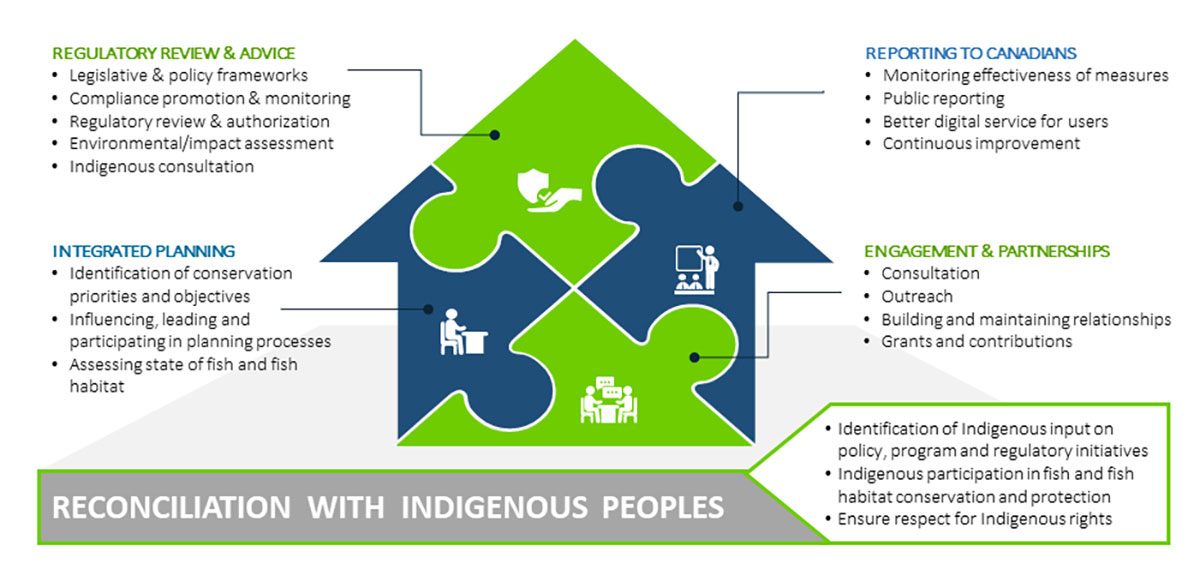
Infographic: Fish and fish habitat protection program – Key pillars and priorities – 2021-22
Regulatory review & advice includes:
- legislative & policy frameworks
- compliance promotion & monitoring
- regulatory review & authorization
- environmental/impact assessment
- indigenous consultation
Integrated planning includes:
- identification of conservation
- priorities and objectives
- influencing, leading and participating in planning processes
- assessing state of fish and fish habitat
Reporting to Canadians includes:
- monitoring effectiveness of measures
- public reporting
- better digital service for users
- continuous improvement
Engagement & partnerships includes:
- consultation
- outreach
- building and maintaining relationships
- grants and contributions
Reconciliation with indigenous peoples includes:
- identification of Indigenous input on policy, program and regulatory initiatives
- Indigenous participation in fish and fish habitat conservation and protection
- ensure respect for indigenous rights
Integrated planning addresses a recommendation from the Standing Committee on Fisheries and Oceans:
“that Fisheries and Oceans Canada take an ecosystem approach to protection and restoration of fish habitats so that the entire food web is preserved for fish by:
- Adopting key sustainability principles.
- Protecting the ecological integrity of fish habitat.
- Protecting key areas of fish habitat.”
In 2021-22, we planned to further work in collaboration with provinces and territories and stakeholders, and Indigenous Peoples, to establish management priorities, to identify sensitive habitats, and to understand the needs and objectives of resources users.
Conservation and protection program
We are responsible for monitoring compliance with legislation and regulations set up to conserve and protect fish and fish habitat. Our fishery officers are authorized by the Minister to enforce fisheries regulations, including the fish and fish habitat protection provisions of the Fisheries Act. To complete this work, we conduct at-sea and inland patrols in marine and freshwater areas, monitor catches, conduct investigations, and give information to fish harvesters about relevant regulations and conditions of licence. Our fishery officers also devote a lot of time to conserve and protect habitat, as described in Section 2.4 above.
Conservation and Protection's compliance and enforcement activities are delivered based on an intelligence-led, three-pillar approach:
- Education, Shared Stewardship and Stakeholder Engagement including informal and formal education programs and co-management/partnership agreements.
- Monitoring, Control and Surveillance including activities such as land, sea and air patrols, inspections and compliance monitoring of third-party service providers, and enforcement response to non-compliance.
- Major Cases/Special Investigations including formal intelligence gathering and analysis, forensic audits, and prosecutions.
Environment and Climate Change Canada
Industrial sectors and chemicals directorate
The Industrial Sector and Chemicals Directorate within ECCC is the departmental lead on administration of the pollution prevention provisions of the Fisheries Act. The Directorate is responsible for policy development, the administration of the general prohibition of the Act (subsection 36(3)), and regulatory development and implementation under the provisions.
The Fisheries Act is one of the main federal statutes used to protect Canadian fisheries and to prevent water pollution. Therefore, the administration of the pollution prevention provisions of the Fisheries Act is a key contributor to the protection and conservation of Canada's water resources.
There are two organizations within the Industrial Sector and Chemicals Directorate which focus on different sector expertise and the administration of the Act. The Mining and Processing Division focusses on projects pertaining to metal and diamond mines, and the administration of the Metal and Diamond Mining Effluent Regulations. The Division is also responsible for the development of Coal Mining Effluent Regulations and the current collaborative work with nine Indigenous communities to explore options to manage the accumulation of oil sands process-affected water in existing tailings ponds. The Forest Products and Fisheries Act Division meanwhile works on projects pertaining to substance and effluent deposits from pulp and paper mills, metal and diamond mines and wastewater treatment plants in Canadian waters. This division is also responsible for the administration of the Pulp and Paper Effluent Regulations, the Wastewater Systems Effluent Regulations and the general prohibition of the Fisheries Act.
Compliance with the general prohibition of subsection 36(3) of the Fisheries Act, which prohibits the deposit of any type of deleterious (harmful) substance in Canadian water bodies frequented by fish, has always been at the forefront of our work. We continue to monitor and closely analyze the general prohibition to ensure compliance with the help of ECCC's Environmental Enforcement Directorate.
Environmental enforcement directorate
The Enforcement Branch's Environmental Enforcement Directorate supports ECCC's mandate to protect and conserve our natural heritage, and ensure a clean, safe and sustainable environment for present and future generations. We do this by enforcing federal legislation that protects the Canadian environment, including the pollution prevention provisions of the Fisheries Act and its associated regulations.
The Directorate consists of environmental enforcement officers that work in five regions across Canada:
- Atlantic Region
- Quebec Region
- Ontario Region
- Prairie and Northern Region, and
- Pacific and Yukon Region
The Environmental Enforcement Directorate also has teams in the National Capital Region that support the work of environmental enforcement officers by:
- participating in the review of existing or new legislation to ensure that enforceability issues are identified and addressed
- collaborating with partners and bringing together environmental enforcement officers and other experts to share information, address issues, and develop consistent enforcement approaches
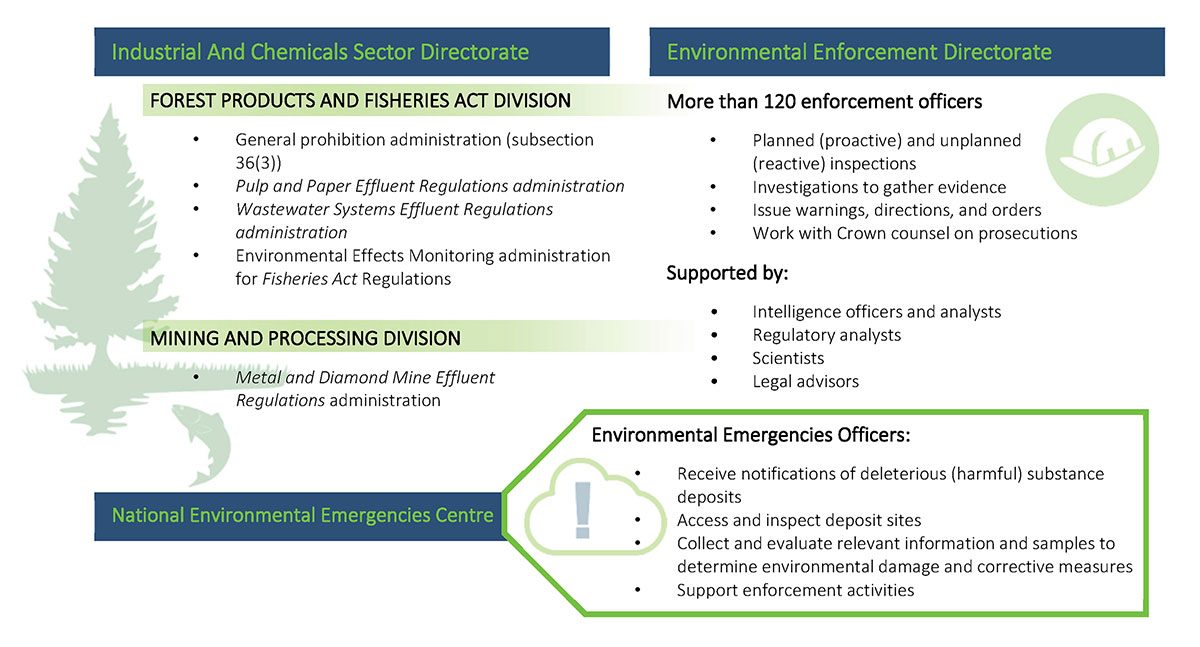
Infographic: Environment and Climate Change Canada – Key roles and responsibilities – 2021-22
Industrial and chemicals sector directorate
- Forest products and fisheries act division:
- General prohibition administration (subsection 36(3))
- Pulp and Paper Effluent Regulations administration
- Wastewater Systems Effluent Regulations administration
- Environmental Effects Monitoring administration for Fisheries Act Regulations
- Mining and processing division:
- Metal and Diamond Mine Effluent Regulations administration
Environmental enforcement directorate
- More than 120 enforcement officers:
- planned (proactive) and unplanned (reactive) inspections
- investigations to gather evidence
- issue warnings, directions and orders
- work with crown counsel on prosecutions
- Supported by:
- Intelligence officers and analysts
- Regulatory analysts
- Scientists
- Legal advisors
National environmental emergencies centre
- Environmental emergencies officers:
- receive notifications of deleterious (harmful) substance deposits
- access and inspect deposit sites
- collect and evaluate relevant information and samples to determine environmental damage and corrective measures
- support enforcement activities
4.4 Tables
Fisheries and Oceans Canada
| Determination | 2021-22 |
|---|---|
| Deemed unlikely to result in harmful alteration, disruption or destruction of fish habitat or death of fish as proponents proposed to use DFO's “Measures to protect fish and fish habitat” or “Codes of Practice” | 216 |
| Deemed unlikely to result in harmful alteration, disruption or destruction of fish habitat or death of fish after additional review/input from the Canada Energy Regulator | 56 |
| Deemed likely to result in harmful alteration, disruption or destruction of fish habitat or death of fish and referred to DFO | 44 |
| Total | 316 |
| Determination | 2021-22 |
|---|---|
| Deemed to be compliant with the Canada Energy Regulator Act and Fisheries Act requirements for fish and fish habitat protection | 121 |
| Non-compliance with the Canada Energy Regulator Act requirements for fish and fish habitat protection addressed by the Canada Energy Regulator | 16 |
| Non-compliance with Fisheries Act - notification/discussion with DFO | 0 |
| Total | 137 |
| Region | Primary Impact | |||||||||
|---|---|---|---|---|---|---|---|---|---|---|
| Changes in Flows/Water Levels | Deposition of Non-Deleterious Substances | Dredging/Excavating | Fish Mortality | Fish Passage | Infilling/Footprint | Watercourse Alteration | No Potential Impact | OtherFootnote 12 | Total | |
| Newfoundland and Labrador | 5 | 11 | 15 | 1 | 65 | 110 | 1 | 46 | 7 | 261 |
| Maritimes | 30 | 13 | 39 | 15 | 89 | 163 | 28 | 83 | 3 | 463 |
| Gulf | 3 | 3 | 51 | 8 | 95 | 138 | 25 | 156 | 0 | 479 |
| Quebec | 12 | 9 | 48 | 29 | 60 | 130 | 5 | 88 | 10 | 391 |
| Ontario & Prairies and Arctic* | 64 | 25 | 763 | 57 | 242 | 1,022 | 29 | 174 | 21 | 2,397 |
| Pacific | 35 | 11 | 137 | 33 | 45 | 837 | 94 | 25 | 79 | 1,296 |
| Total | 149 | 72 | 1,053 | 143 | 596 | 2,400 | 182 | 572 | 120 | 5,287 |
| * For the purpose of this report, Ontario & Prairies and Arctic includes the provinces of Alberta, Saskatchewan, Manitoba, and Ontario, as well as the Northwest Territories and Nunavut. Covering more than 2/3 of Canada, these regions typically report higher numbers. | ||||||||||
| Region | Advice/Response Provided to Proponent or OthersFootnote 13 | Authorizations Issued | Total |
|---|---|---|---|
| Newfoundland and Labrador | 279 | 4 | 283 |
| Maritimes | 453 | 25 | 478 |
| Gulf | 467 | 14 | 481 |
| Quebec | 454 | 46 | 500 |
| Ontario & Prairies and Arctic | 2,298 | 60 | 2,358 |
| Pacific | 1,188 | 63 | 1,251 |
| Total | 5,139 | 212 | 5,351 |
|
Advice/Response numbers do not include any Impact Assessment advice actions as they were excluded in FY 2021-22. “Authorization Issued” numbers include both authorizations and amendments issued, so they are higher than the number of files. If a file is issued both an authorization and an amendment in FY 2021-22, it would also be counted as two authorizations issued. |
|||
| Region | Class Authorizations Notifications | Code of Practice Notifications* | Total |
|---|---|---|---|
| Newfoundland and Labrador | 0 | 8 | 8 |
| Maritimes | 0 | 14 | 14 |
| Gulf | 0 | 7 | 7 |
| Quebec | 0 | 22 | 22 |
| Ontario & Prairies and Arctic | 171 | 451 | 622 |
| PacificFootnote 14 | 24 | 143 | 167 |
| Total | 195 | 645 | 840 |
| * New: data on the number of voluntary notifications received for Codes of Practice. Project proponents that follow Codes of Practice are asked to notify the department about how they are used to avoid harmful impacts to fish and fish habitat. This notification, when provided, enables tracking, monitoring, and reporting. | |||
| Habitat Activities | Hours* | Percentage* |
|---|---|---|
| Agriculture | 2,561 | 6% |
| Aquaculture | 203 | 1% |
| Death of Fish | 1,762 | 5% |
| Forestry | 1,714 | 4% |
| General Patrol | 6,695 | 16% |
| Hydro | 859 | 2% |
| Industrial/Commercial | 2,446 | 6% |
| Mining | 3,803 | 9% |
| Natural Event | 289 | 1% |
| Oil/Gas | 1,594 | 4% |
| Other (Non-Industry) | 2,958 | 7% |
| Recreational | 3,033 | 7% |
| Rural/Urban Development | 10,303 | 25% |
| Transportation | 2,805 | 7% |
| Total | 41,025 | 100% |
| * rounded to nearest whole number | ||
| Region | Warnings Issued | Fisheries Act Direction | Charges Laid | Alternatives to Prosecution* |
|---|---|---|---|---|
| Newfoundland and Labrador | 0 | 0 | 0 | 0 |
| Maritimes | 2 | 3 | 3 | 0 |
| Gulf | 1 | 8 | 0 | 0 |
| Quebec | 5 | 0 | 0 | 0 |
| Ontario & Prairies and Arctic | 7 | 7 | 0 | 0 |
| Pacific | 12 | 0 | 10 | 1 |
| Total | 27 | 18 | 13 | 1 |
| *Alternatives to prosecution include out of court settlements aimed at restoring fish and fish habitat that have been harmed. | ||||
| Region | Number of Occurrences |
|---|---|
| Newfoundland and Labrador | 140 |
| Maritimes | 104 |
| Gulf | 134 |
| Quebec | 21 |
| Ontario & Prairies and Arctic | 57 |
| Pacific | 620 |
| Total | 1076 |
| Region | Number of Occurrences |
|---|---|
| Newfoundland and Labrador | 0 |
| Maritimes | 0 |
| Gulf | 0 |
| Quebec | 0 |
| Ontario & Prairies and Arctic | 0 |
| Pacific | 2 |
| Total | 2 |
Environment and Climate Change Canada
| Instruments | Total | On-Site | Off-Site |
|---|---|---|---|
| Fisheries Act (Grand Total) | 1,887 | 417 | 1,470 |
| General ProhibitionFootnote 16 | 763 | 283 | 480 |
| Deposit Out of Normal Course of Events Notification Regulations | 6 | 0 | 6 |
| Metal and Diamond Mining Effluent Regulations | 682 | 70 | 612 |
| Petroleum Refinery Liquid Effluent Regulations | 1 | 0 | 1 |
| Pulp and Paper Effluent Regulations | 190 | 19 | 171 |
| Wastewater Systems Effluent Regulations | 240 | 45 | 195 |
| Measure Type | ||||
|---|---|---|---|---|
| Details | Written Warnings | Directions | ||
| Instruments | No. of Letters | No. of InfractionsFootnote 18 | No. of Directions | No. of Infractions |
| Fisheries Act (Grand Total) | 149 | 313 | 12 | 27 |
| General ProhibitionFootnote 19 | 51 | 80 | 11 | 11 |
| Metal and Diamond Mining Effluent Regulations | 33 | 62 | - | - |
| Pulp and Paper Effluent Regulations | 12 | 17 | - | - |
| Wastewater Systems Effluent Regulations | 53 | 154 | 1 | 6 |
| Instruments | Started before the fiscal year and ongoing after the fiscal year | Started in the fiscal year | Ended in the Fiscal year |
|---|---|---|---|
| Fisheries Act (Grand Total) | 48 | 8 | 25 |
| General Prohibition | 36 | 8 | 24 |
| Metal and Diamond Mining Effluent Regulations | 9 | 0 | 1 |
| Pulp and Paper Effluent Regulations | 3 | 0 | 0 |
| Wastewater Systems Effluent Regulations | 1 | - | 3 |
| Prosecutions | Penalties | ||
|---|---|---|---|
| Instruments | Convicted SubjectsFootnote 20 | Guilty CountsFootnote 21 | Environmental Damages Fund |
| Fisheries Act (Grand Total) | 45 | 4 | $2,985,000 |
| General ProhibitionFootnote 22 | 3 | 3 | $2,560,000 |
| Metal and Diamond Mining Effluent Regulations | 1 | 1 | $125,000 |
4.5 Year-over-year comparative statistics
In our 2020-21 annual report, we presented comparative data sets from three consecutive fiscal years to enable additional analyses and understanding about the ongoing results of our efforts.
We also committed to continue populating this section of the report to profile comparative data on other activities that we undertake. The following tables and infographics showcase year-over-year statistics for:
- Administering the Fish and Fish Habitat Protection Program – DFO (FY2018-19 – FY2021-22)
- Enforcement Activities for the Fisheries Act – ECCC (FY2018-19 – FY2021-22)
- Monitoring Water Quality for Shellfish – ECCC (FY2018-19 to FY2021-22)
- Self-reported Effluent Data Analysis – ECCC (FY2018-19 to FY2021-22)
- Environmental Emergencies Notifications – ECCC (FY2020-21 to FY2021-22)
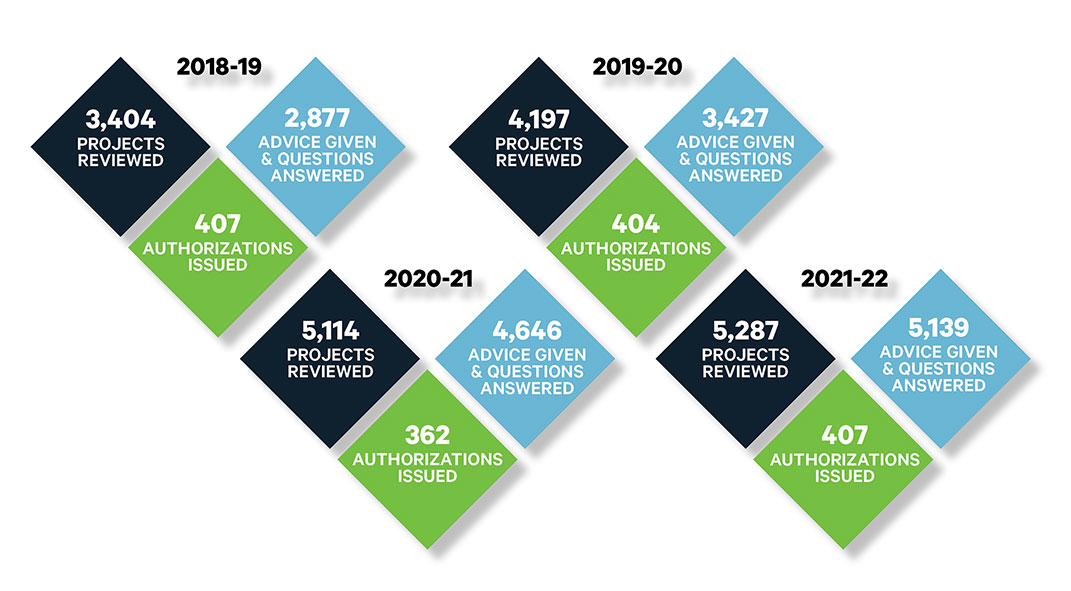
Infographic: Administering the Fish and Fish Habitat Protection Program – fiscal years 2018-19 to 2021-22
2018-19: 3,404 Projects reviewed, 2,877 Advice given and questions answered, and 407 Authorizations Issued.
2019-20: 4,197 Projects reviewed, 3,427 Advice given and questions answered, and 404 Authorizations issued.
2020-21: 5,114 Projects reviewed, 4,646 Advice given and questions answered, and 362 Authorizations issued.
2021-22: 5,287 Projects reviewed, 5,139 Advice given and questions answered, and 407 Authorizations issued.
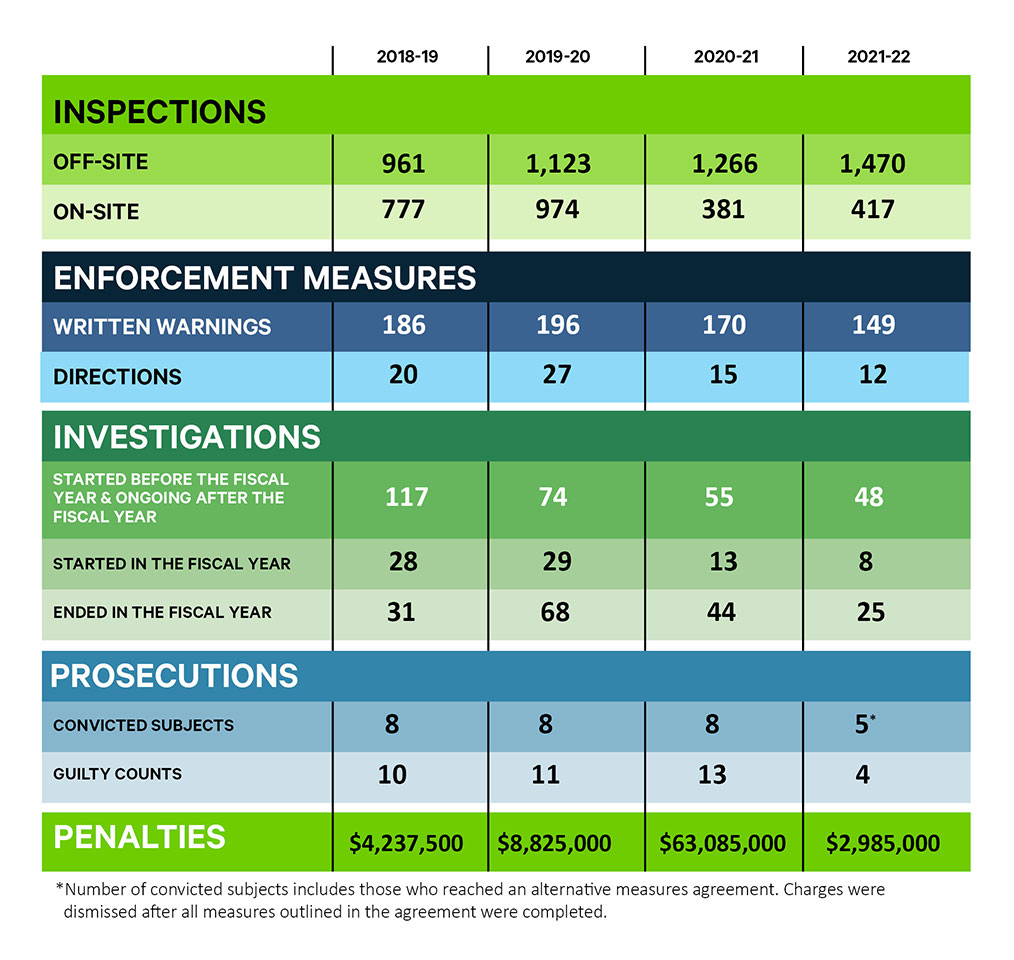
Infographic: Enforcement measures for the Fisheries Act – fiscal years 2018-19 to 2021-22
2018-19
- Inspections: 961 Off-site, 777 On-site.
- Enforcement Measures: 186 Written Warnings, 20 Directions.
- Investigations: 117 started before the fiscal year & ongoing, 28 Started in the Fiscal Year, 31 Ended in the Fiscal Year
- Prosecutions: 8 convicted subjects, 10 Guilty Counts.
- Penalties: $4,237,500
2019-20
- Inspections: 1,123 Off-site, 974 On-site.
- Enforcement Measures: 196 Written Warnings, 27 Directions.
- Investigations: 74 started before the fiscal year & ongoing, 29 Started in the Fiscal Year, 68 Ended in the Fiscal Year
- Prosecutions: 8 convicted subjects, 11 Guilty Counts.
- Penalties: $8,825,000
2020-21
- Inspections: 1,266 Off-site, 381 On-site.
- Enforcement Measures: 170 Written Warnings, 15 Directions.
- Investigations: 55 started before the fiscal year & ongoing, 13 Started in the Fiscal Year, 44 Ended in the Fiscal Year
- Prosecutions: 8 convicted subjects, 13 Guilty Counts.
- Penalties: $63,085,000
2021-22
- Inspections: 1,470 Off-site, 417 On-site.
- Enforcement Measures: 149 Written Warnings, 12 Directions.
- Investigations: 48 started before the fiscal year & ongoing, 8 Started in the Fiscal Year, 25 Ended in the Fiscal Year
- Prosecutions: 5* convicted subjects, 4 Guilty Counts.
- Penalties: $2,985,000
* Number of convicted subjects includes those who reached an alternative measures agreement. Charges were dismissed after all measures outlined in the agreement were completed.
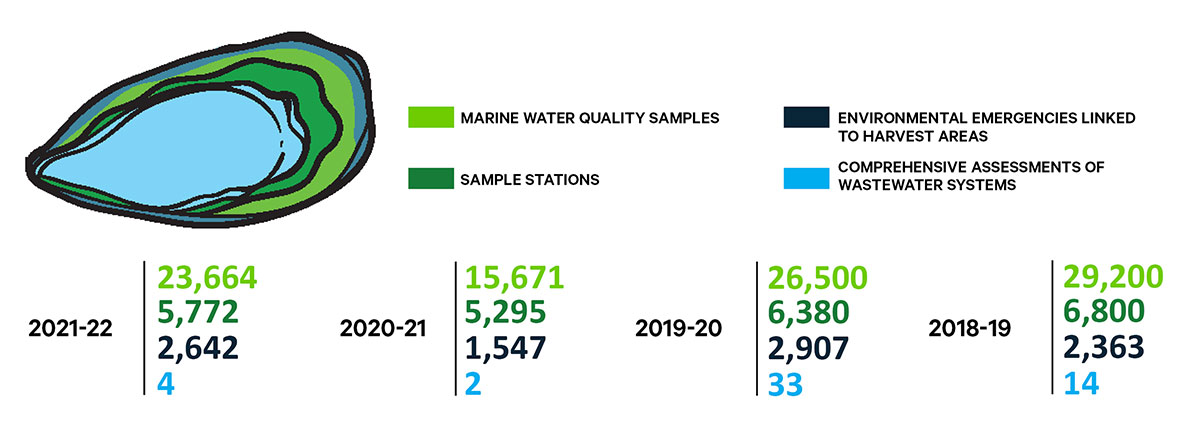
Infographic: Monitoring water quality for shellfish – fiscal years 2018-19 to 2021-22
2018-19
- 29,200 Marine Water Quality Samples,
- 6,800 Sample Stations,
- 2,363 Environmental Emergencies Linked to Harvest Areas,
- 14 Comprehensive Assessments of Wastewater Systems
2019-20
- 26,500 Marine Water Quality Samples,
- 6,360 Sample Stations,
- 2,907 Environmental Emergencies Linked to Harvest Areas,
- 33 Comprehensive Assessments of Wastewater Systems
2020-21
- 15,671 Marine Water Quality Samples,
- 5,295 Sample Stations,
- 1,547 Environmental Emergencies Linked to Harvest Areas,
- 2 Comprehensive Assessments of Wastewater Systems
2021-22
- 23,664 Marine Water Quality Samples,
- 5,772 Sample Stations,
- 2,642 Environmental Emergencies Linked to Harvest Areas,
- 4 Comprehensive Assessments of Wastewater Systems
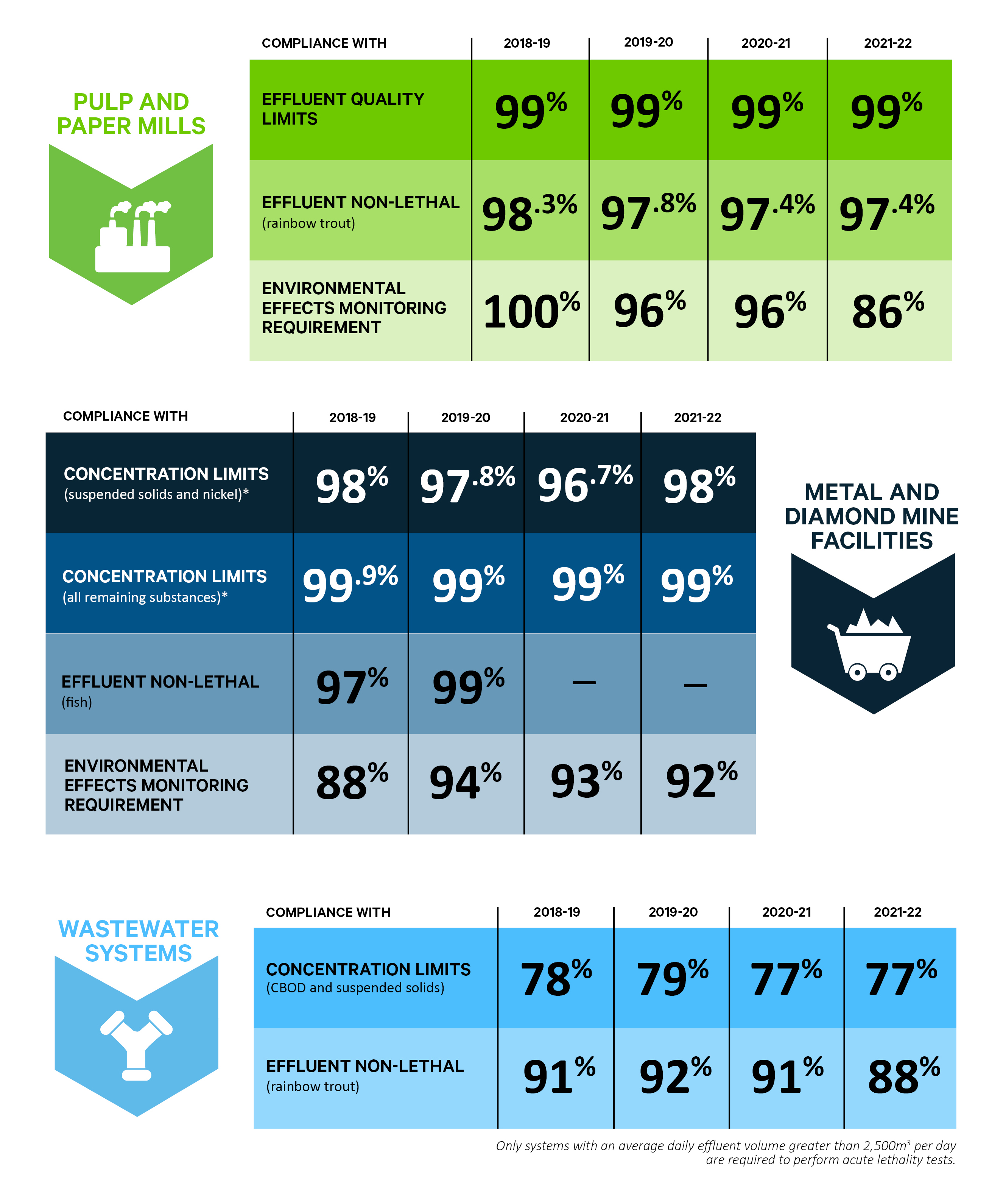
Infographic: Self-reported effluent data analysis in terms of compliance with regulations – fiscal years 2018-19 to 2021-22
2018-19
Pulp and Paper Mills Compliance: 99% Effluent Quality Limits, 98.3% Effluent Non-Lethal (Rainbow Trout), and 100% Environmental Effects Monitoring Requirement
Metal and Diamond Mine Facilities Compliance: 98% Concentration Limits (Suspended Solids and nickel)*, 99.9% Concentration Limits (all remaining Substances)*, 97% Effluent Non-Lethal (fish) and 88% Environmental Effects Monitoring Requirement.
Wastewater Systems Compliance: 78% Concentration Limits (CBOD and suspended solids) and 91% Effluent Non-Lethal (Rainbow Trout)
2019-20
Pulp and Paper Mills Compliance: 99% Effluent Quality Limits, 97.8% Effluent Non-Lethal (Rainbow Trout), and 96% Environmental Effects Monitoring Requirement
Metal and Diamond Mine Facilities Compliance: 97.8% Concentration Limits (Suspended Solids and nickel)*, 99% Concentration Limits (all remaining Substances)*, 99% Effluent Non-Lethal (fish) and 94% Environmental Effects Monitoring Requirement.
Wastewater Systems Compliance: 79% Concentration Limits (CBOD and suspended solids) and 92% Effluent Non-Lethal (Rainbow Trout)
2020-21
Pulp and Paper Mills Compliance: 99% Effluent Quality Limits, 97.4% Effluent Non-Lethal (Rainbow Trout), and 96% Environmental Effects Monitoring Requirement
Metal and Diamond Mine Facilities Compliance: 96.7% Concentration Limits (Suspended Solids and nickel)*, 99% Concentration Limits (all remaining Substances)*, and 93% Environmental Effects Monitoring Requirement.
Wastewater Systems Compliance: 77% Concentration Limits (CBOD and suspended solids) and 91% Effluent Non-Lethal (Rainbow Trout)
2021-22
Pulp and Paper Mills Compliance: 99% Effluent Quality Limits, 97.4% Effluent Non-Lethal (Rainbow Trout), and 86% Environmental Effects Monitoring Requirement
Metal and Diamond Mine Facilities Compliance: 98% Concentration Limits (Suspended Solids and nickel)*, 99% Concentration Limits (all remaining Substances)* and 92% Environmental Effects Monitoring Requirement.
Wastewater Systems Compliance: 77% Concentration Limits (CBOD and suspended solids) and 88% Effluent Non-Lethal (Rainbow Trout)
*Only systems with an average daily effluent volume greater than 2,500 cubic meters per day are required to perform acute lethality tests.
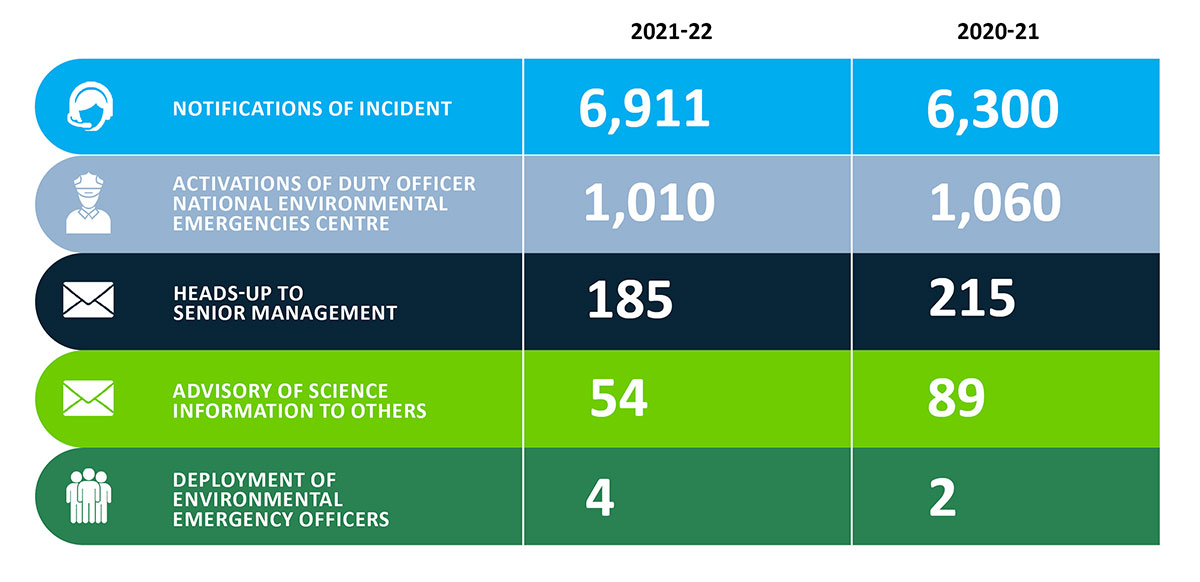
Infographic: Environmental emergencies notifications related to the Fisheries Act – fiscal years 2020-21 to 2021-22
2020-21:
6,300 Notifications of Incident, 1,060 Activations of Duty Officer - National Environmental Emergencies Centre, 215 Heads-up to Senior Management, 89 Advisory of Science Information to Others, and two Environmental Emergency Officers Deployed.
2021-22:
6,911 Notifications of Incident, 1,010 Activations of Duty Officer - National Environmental Emergencies Centre, 185 Heads-up to Senior Management, 54 Advisory of Science Information to Others, and four Environmental Emergency Officers Deployed.
- Date modified:
